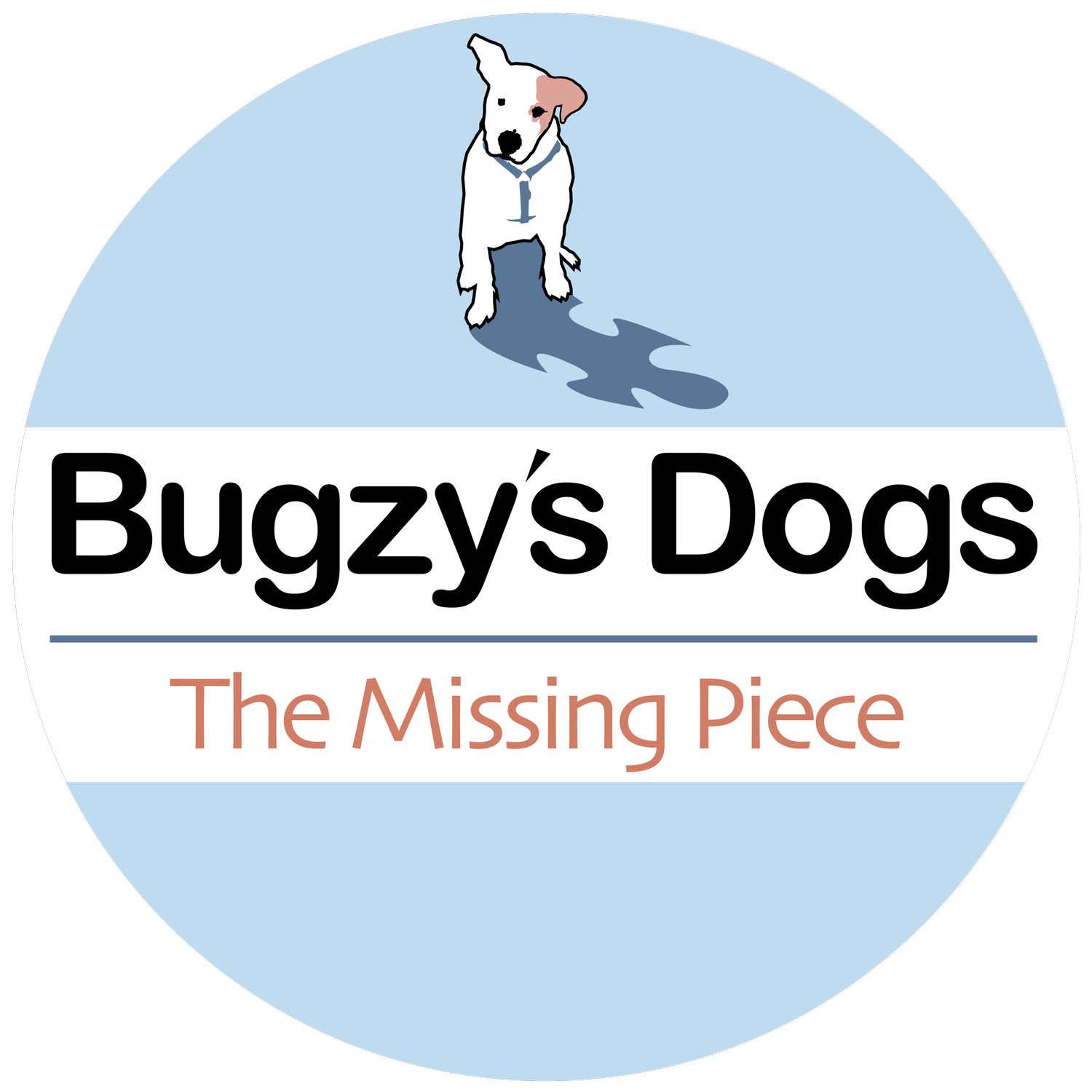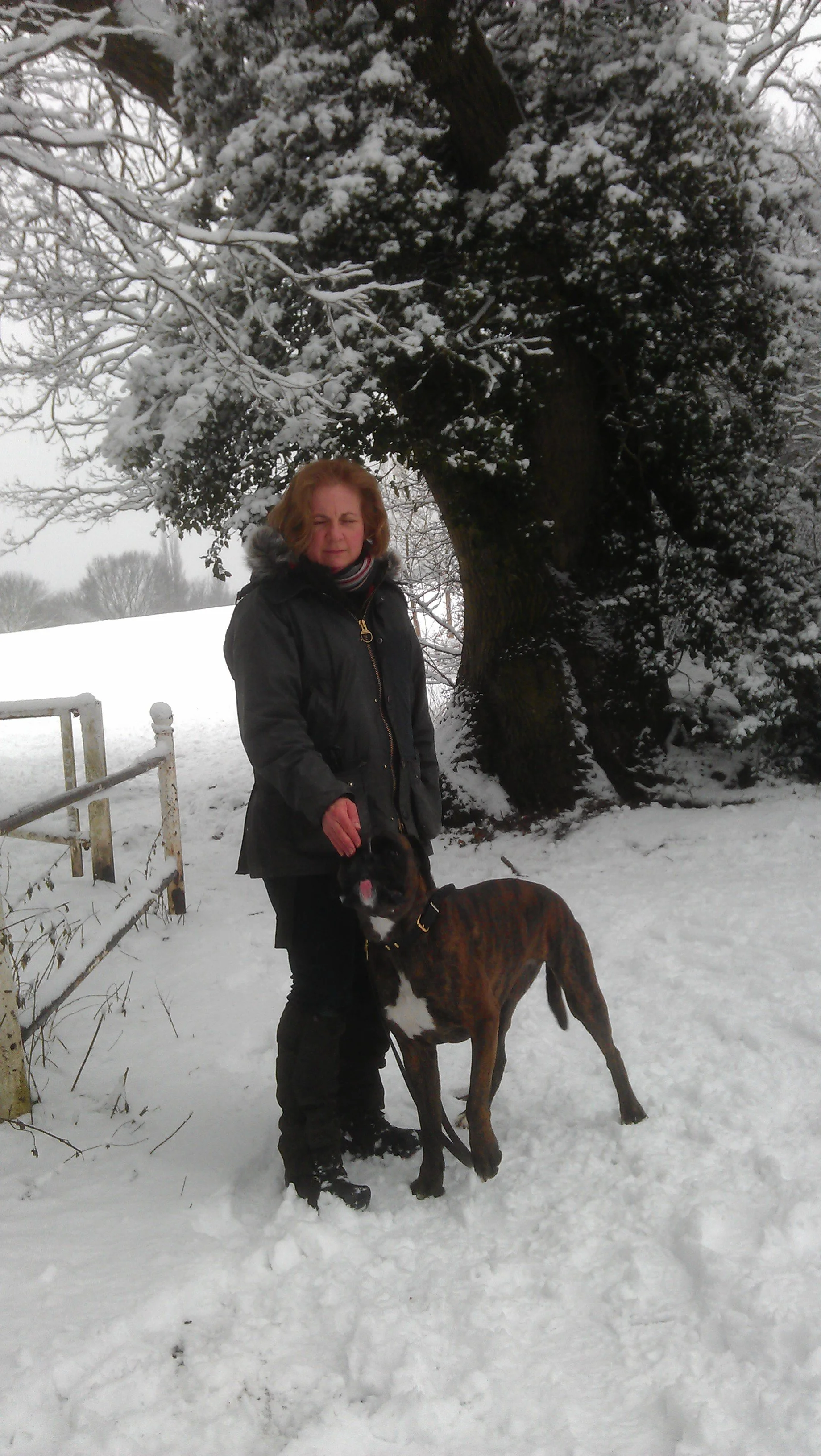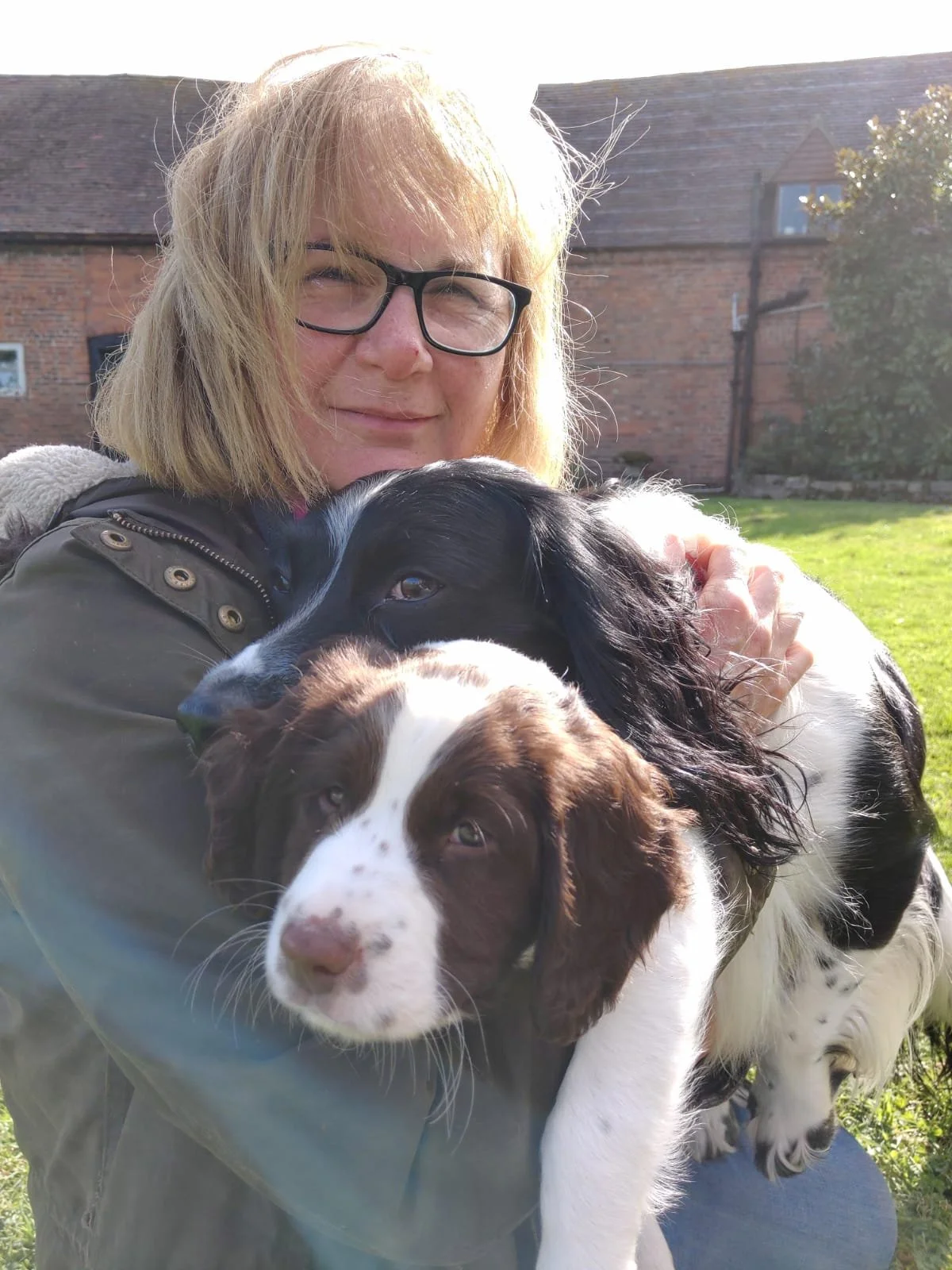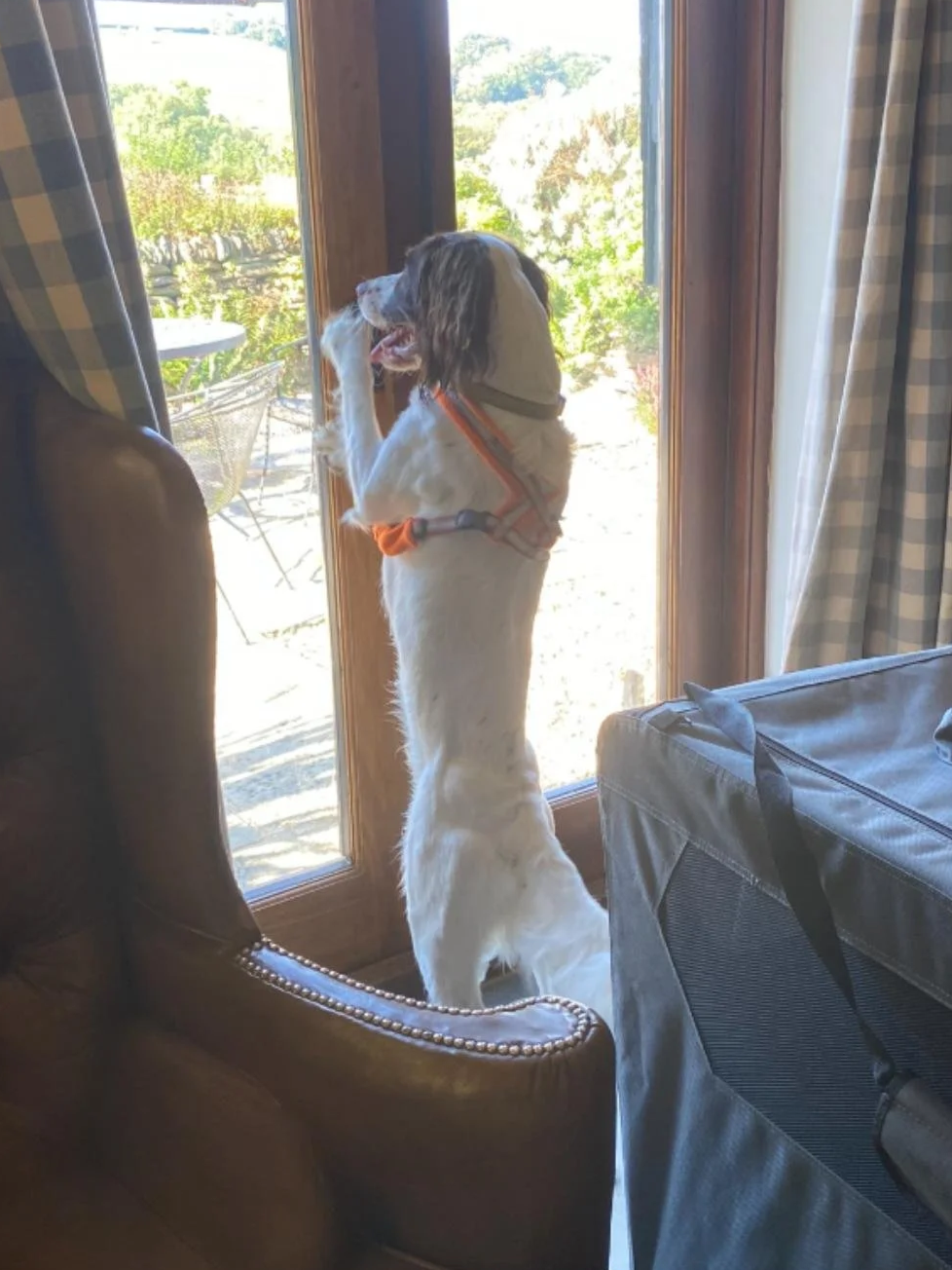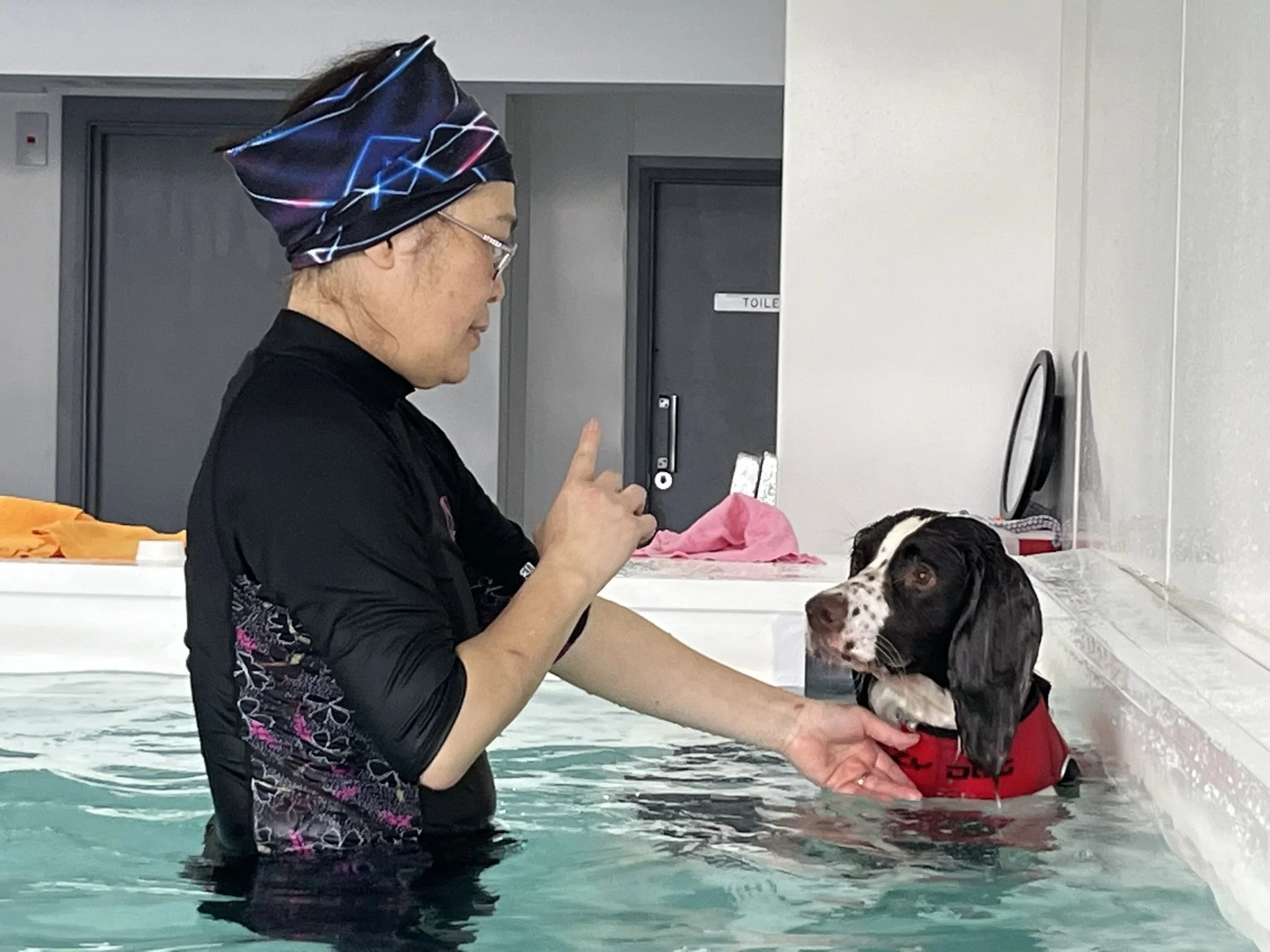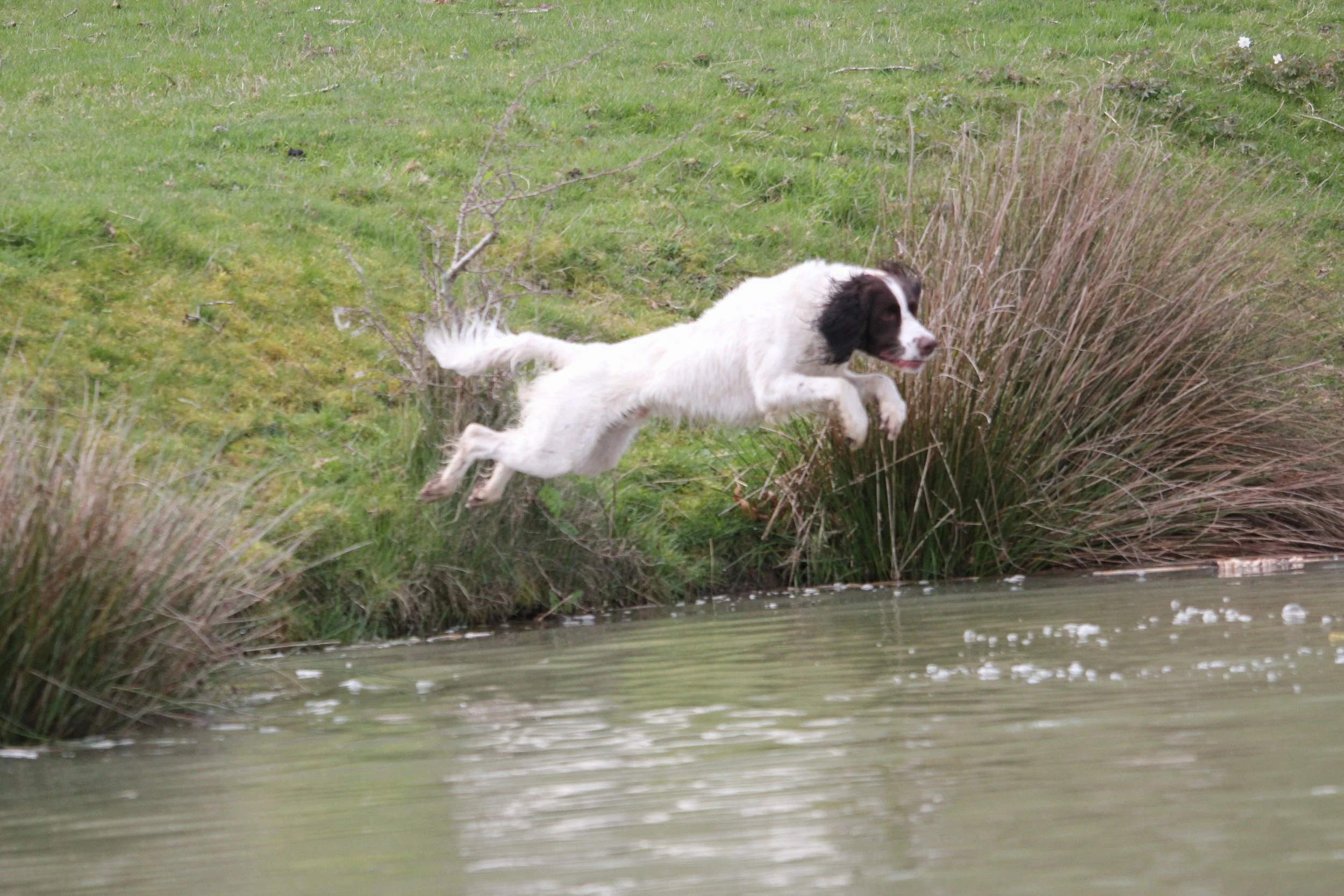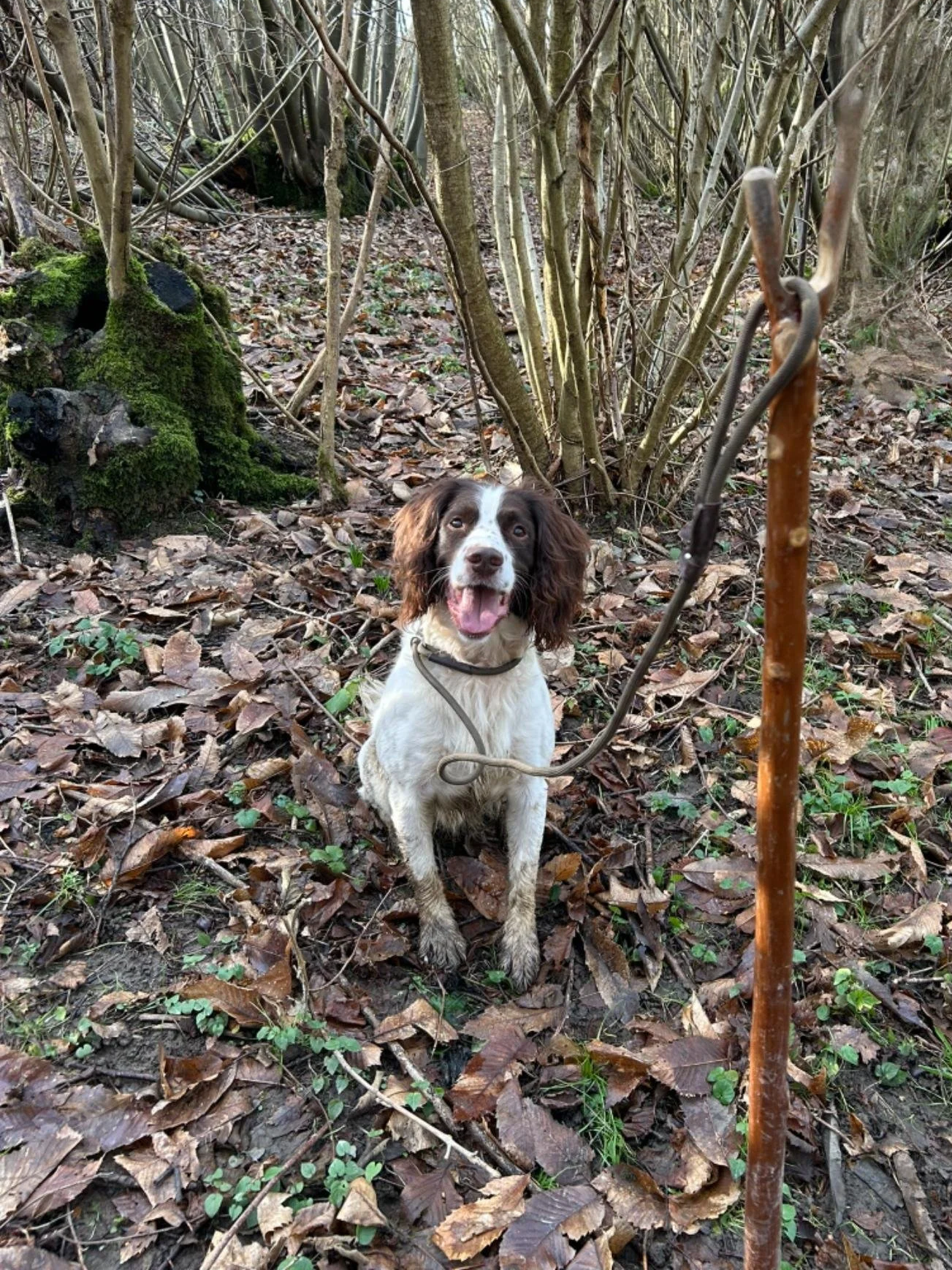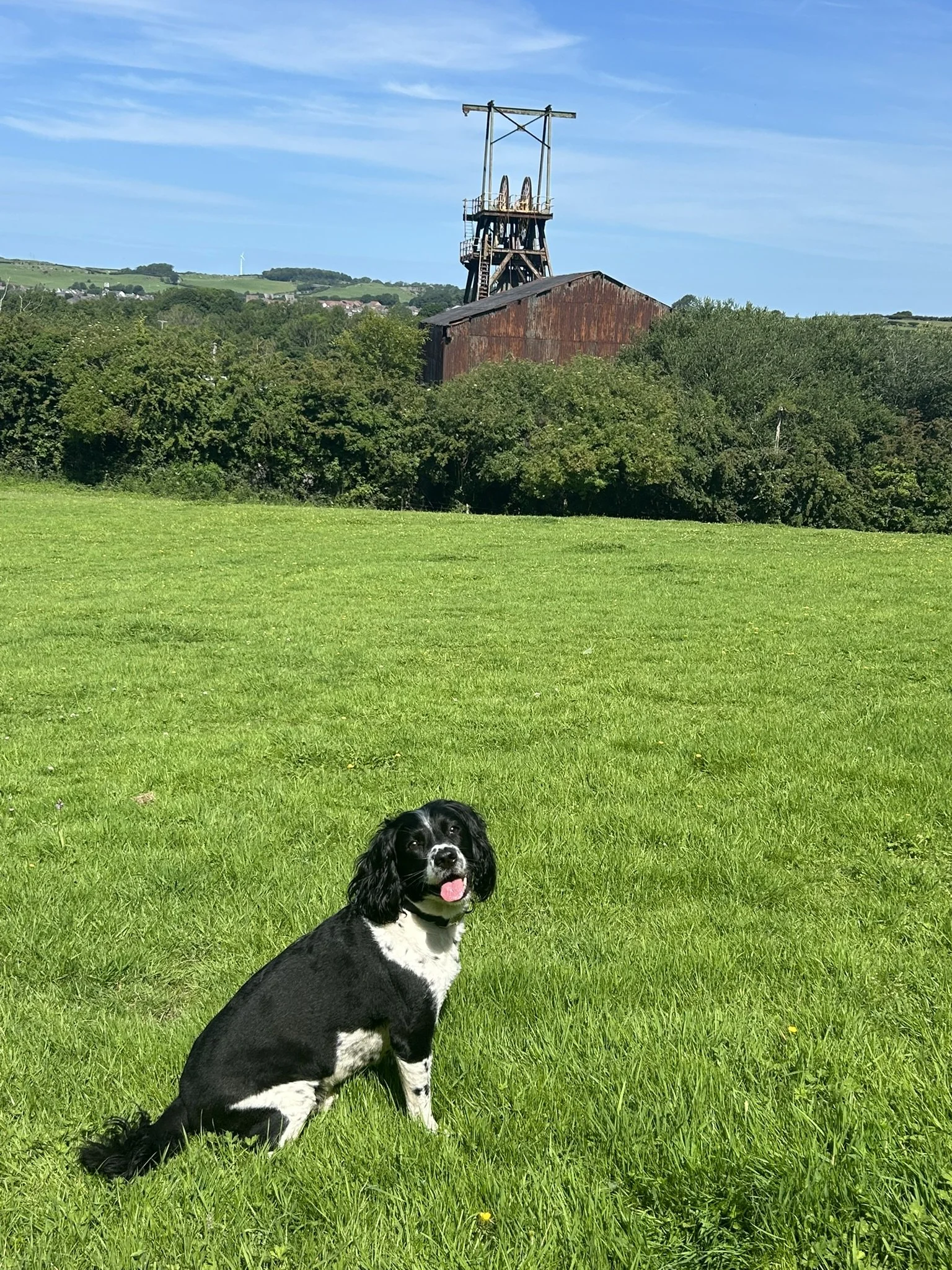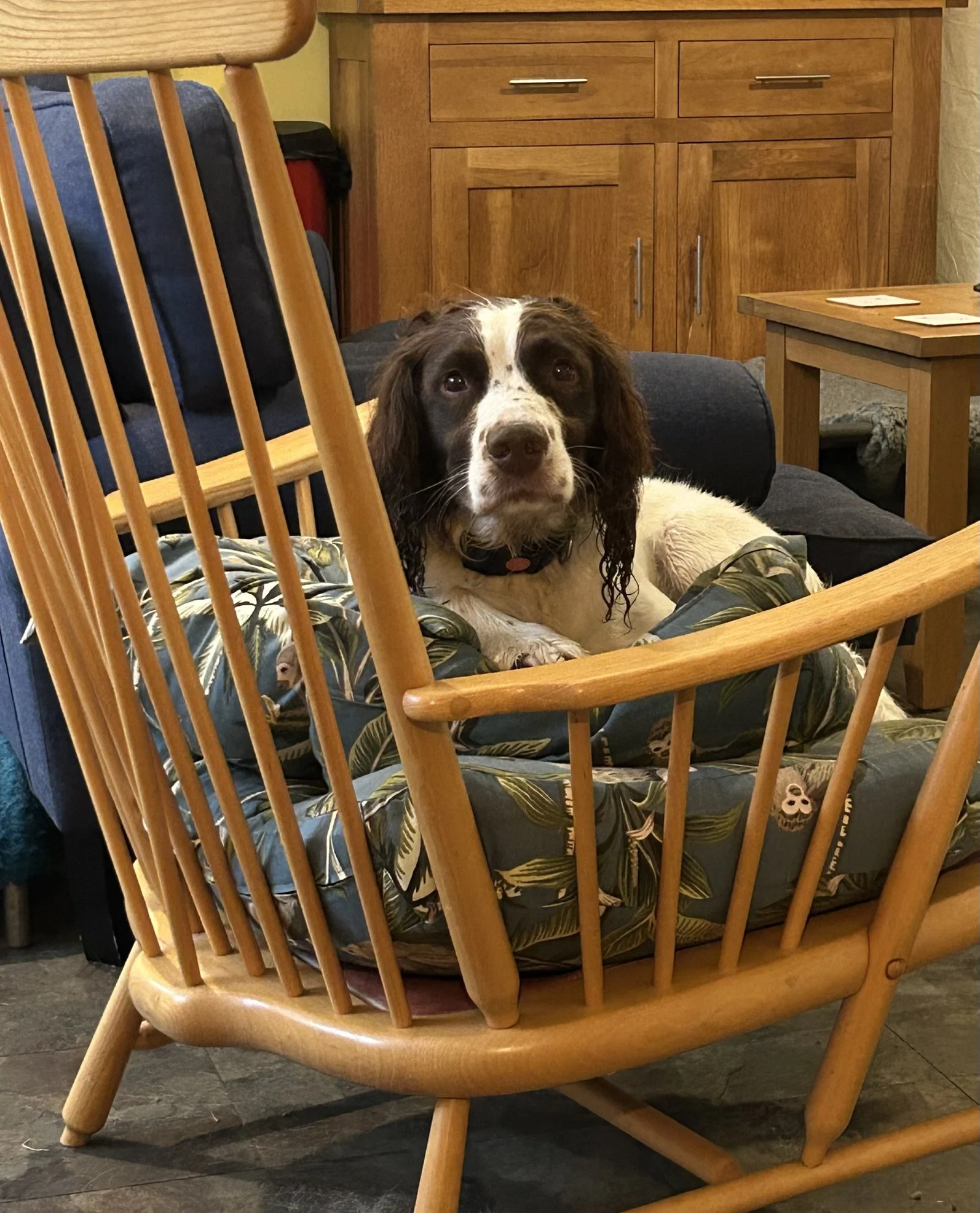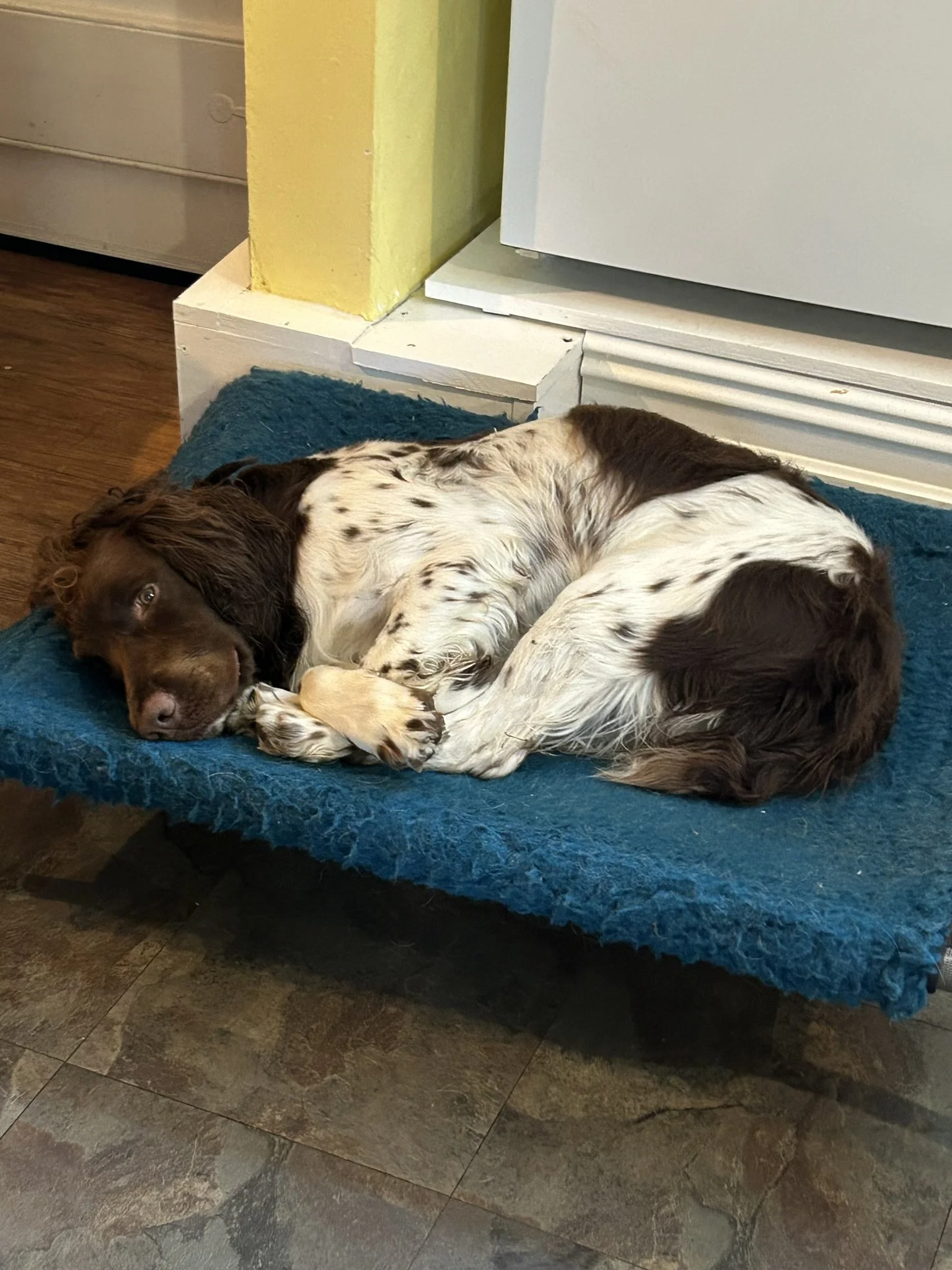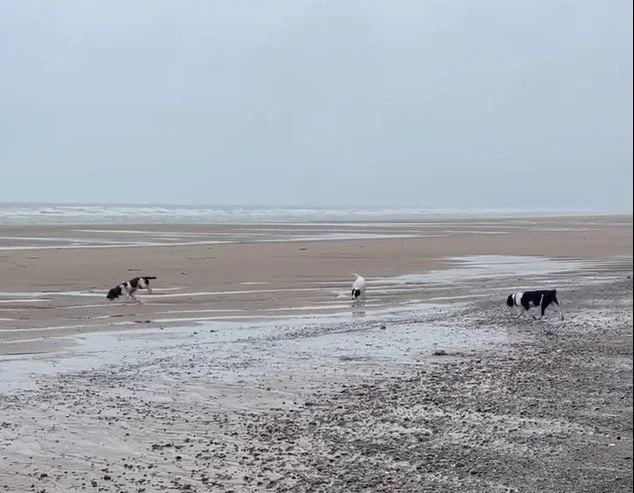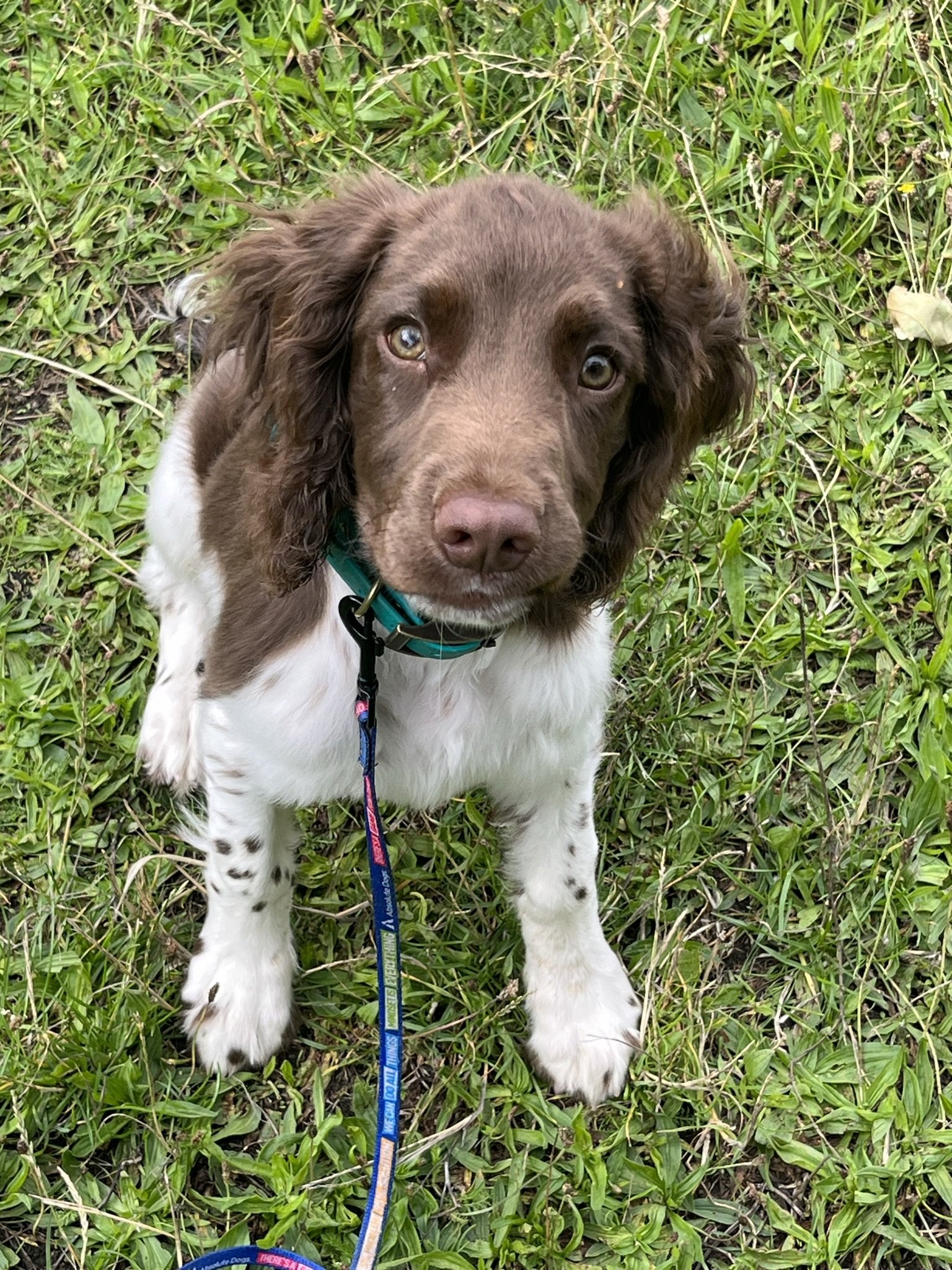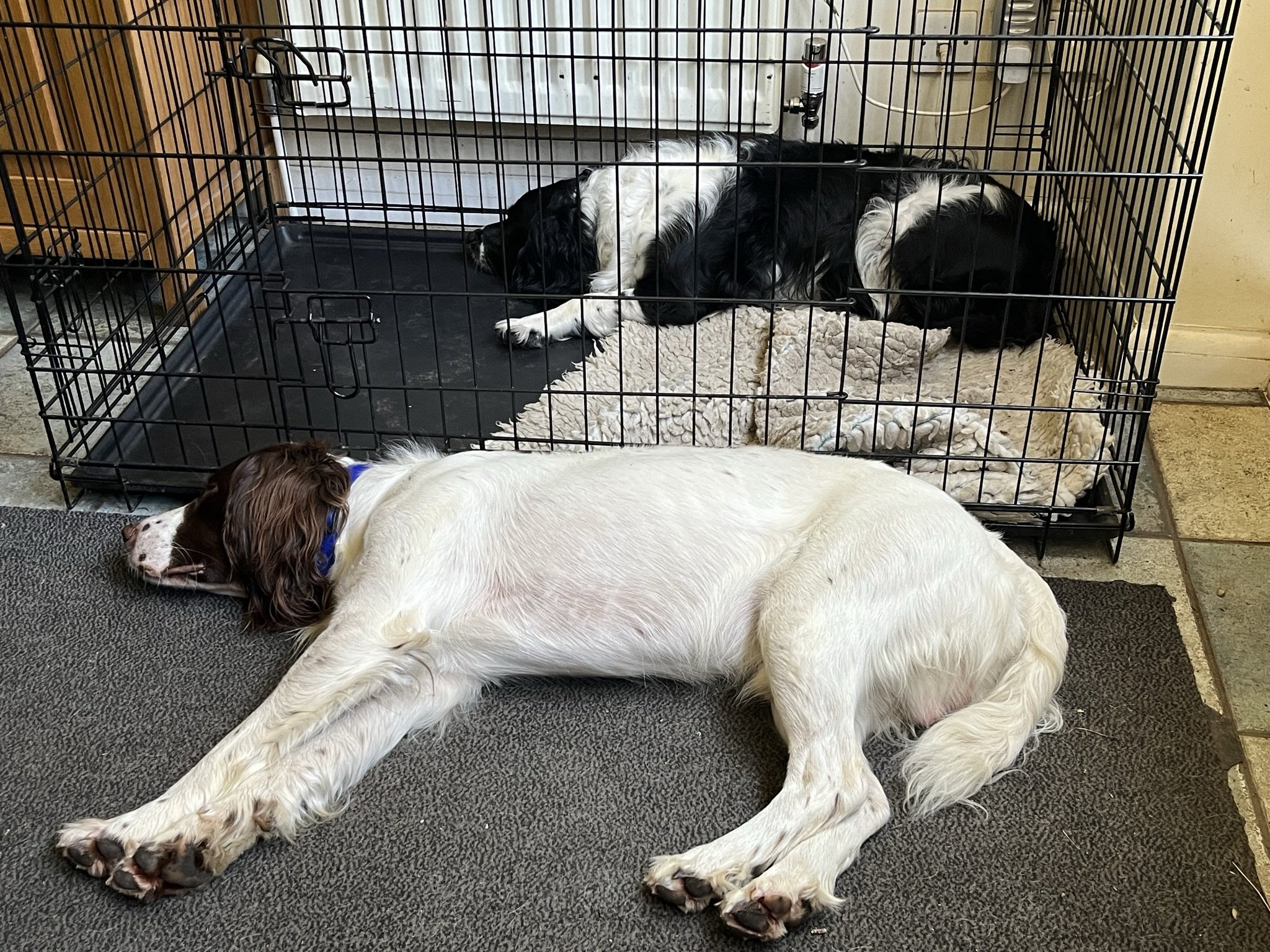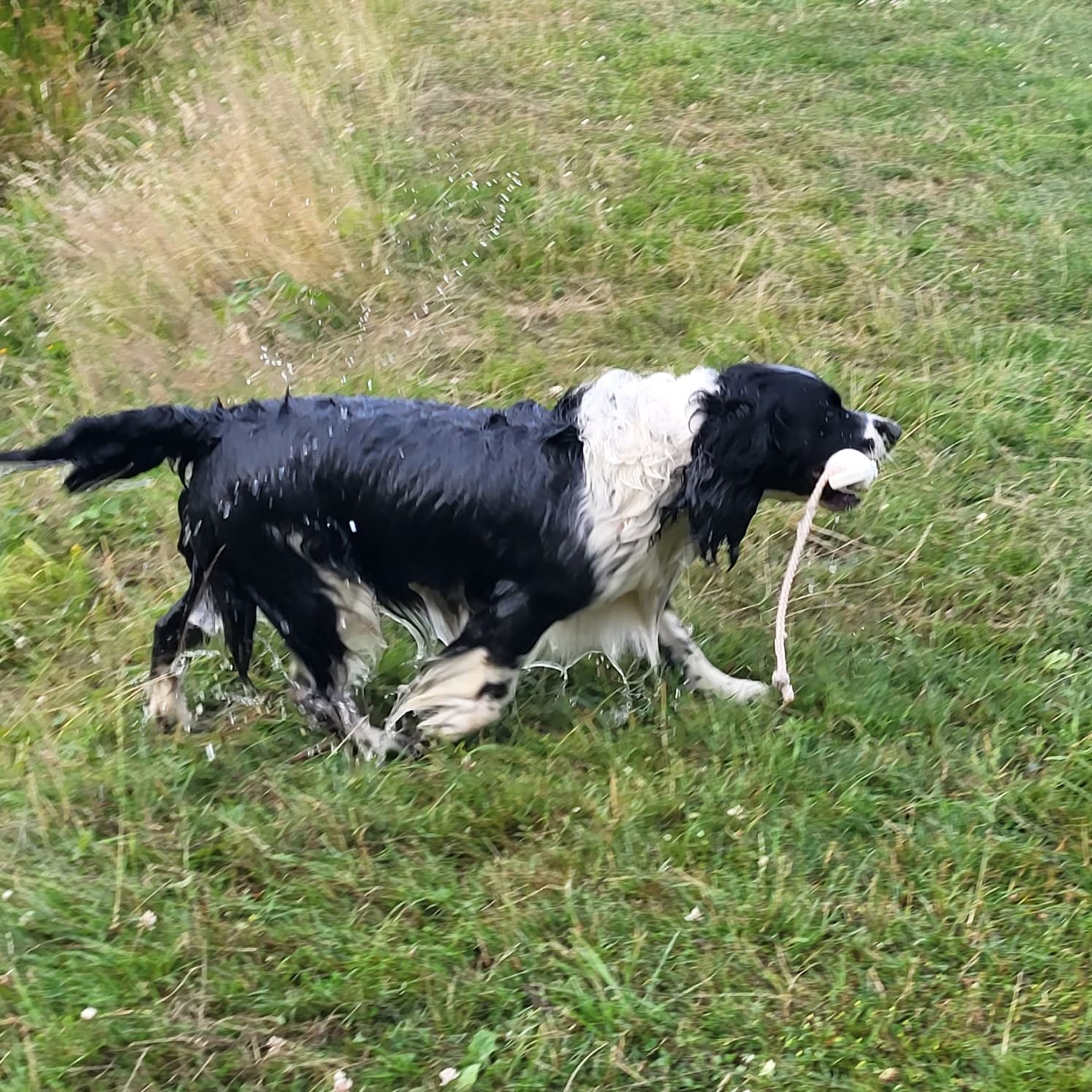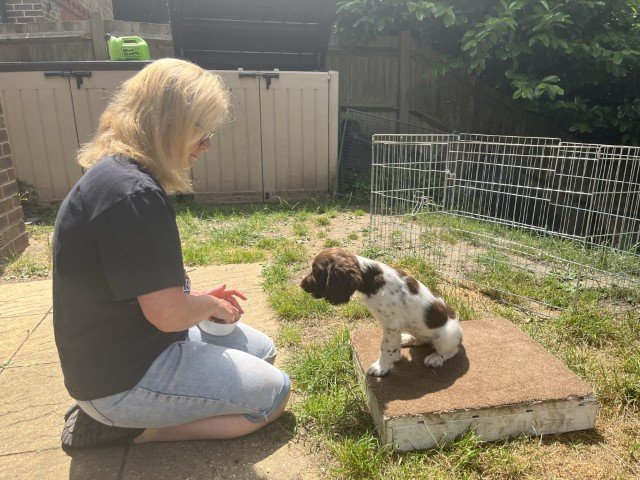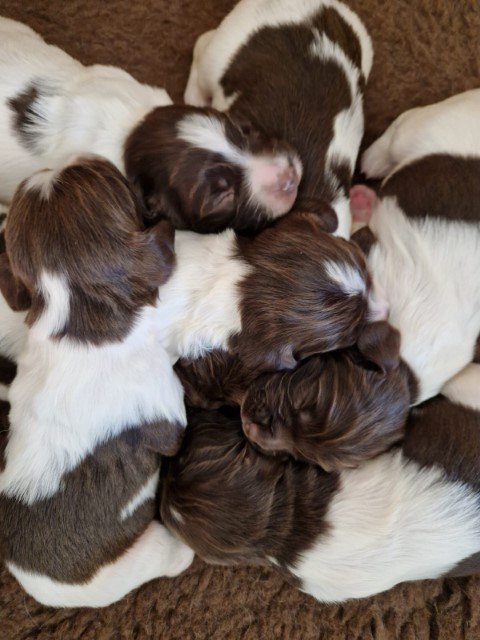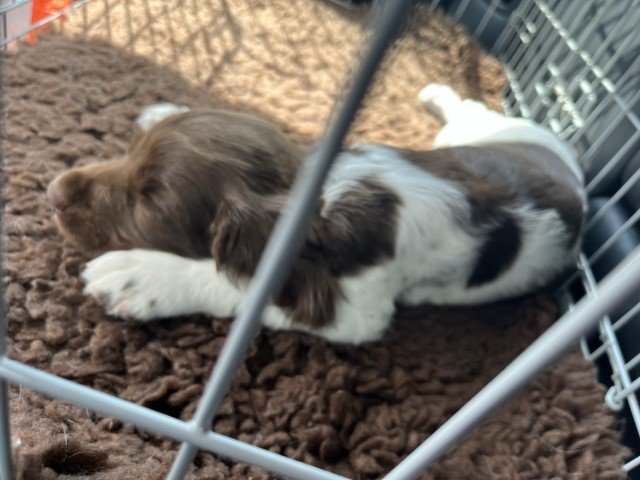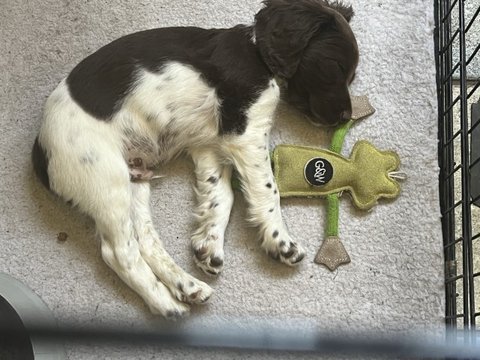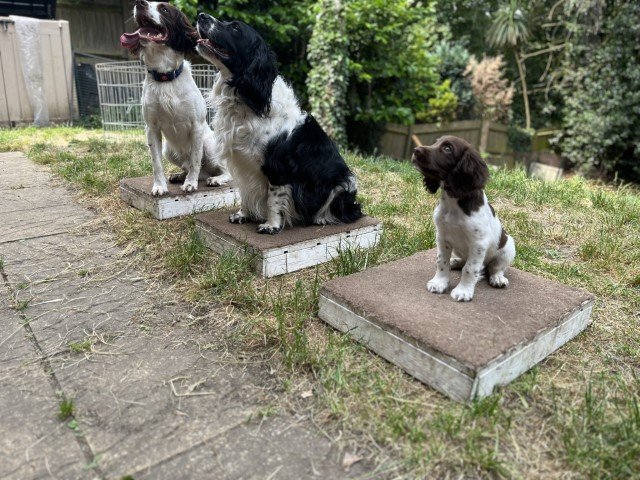Keeping Dogs Safe in UK Winters: Essential Tips for Owners
Winter walks can be magical, with bright sun, crisp air, frosty fields, and maybe even a dusting of snow.
But its important to remember that winter walks can create hazards for dogs.
Preparation for your outside adventures, is key, and will help keep your dog safe.
In Winter, dogs can get cold. Cold weather can lead to hypothermia, especially in vulnerable individuals such as puppies, elderly dogs, and breeds with short hair, such as boxers and staffies.
It’s a good idea to check the temperature before you venture out on a walk. Consider wind chill and other weather conditions, like rain, as well, as these can make a difference.
You can use this table to help you decide what precautions you need to take.
Above 0°C: Generally safe for most dogs, though short-haired breeds may need a coat.
0°C to -5°C: Safe for many dogs, but limit time outdoors. Watch for shivering, lifting paws, or reluctance to walk.
Below -5°C: Risk of frostbite and hypothermia increases. Small, elderly, young, or short-coated dogs should only go out briefly and wearing a coat.
Extreme cold (below -10°C): Dangerous for most dogs. Walks should be very short, and protective gear (coats, paw boots) is strongly advised.
Some dogs are more vulnerable than others to cold weather.
Breed - Huskies and other double-coated breeds have evolved to thrive in cold climates, whereas greyhounds and whippets are highly sensitive to cold weather because of their lean build, low body fat and short coat, they often need to wear a coat or jumper during the winter, and especially if the temperature drops below 5°C.
Coat Type - Short coated breeds are much more vulnerable to the cold compared with long haired or double coated breeds.
Low Body Fat - Dogs with low body fat, lack insulation, and lose body heat quickly; they often need extra protection when temperatures drop.
Size & Age - Puppies, elderly dogs, and small breeds lose heat faster, so for these individuals, make your walk shorter.
General Health - Dogs with arthritis or other conditions may feel the cold more acutely. Cold weather may cause more pain, and make it more difficult for them to move.
Activity Level - A dog running in a field generates more body heat than one strolling along.
Cold weather doesn’t eliminate the need for water, it remains important to provide fresh water indoors and out on walks, and to monitor for signs of dehydration.
Practical Tips for UK Winter Walks with Dogs
Check your dog’s paws after every walk, look for cracking and signs of irritation; ice, grit, and salt can irritate or crack paw pads.
You can protect your dog’s paws by applying paw balm, or by having them wear boots when out on walks.
Wearing a jumper or coat will help your dog stay warm on a walk. There are many different kinds of coats, choose one that is suitable for your dog and the conditions.
Shorten walks during periods of severe cold and keep an eye on your dog, to see how they are coping. If they’re shivering, lifting paws, or trying to go home, they may be too cold. This will be a good time to end your walk and head inside for a warm up.
Beware of Ice and Frozen Water
When it’s very cold, bodies of water may freeze. The ice is often very thin and may crack.
Even if the water isn’t frozen, its still dangerous, even if your dog is a strong swimmer. Plunging into cold water can causes changes within the dog’s body that make it more difficult for them to swim. Cold water quickly reduces muscle strength and coordination, making swimming much harder.Even strong swimmers will tire within minutes, and soon will be unable to keep themselves afloat. Panic and shock can make it harder for a dog to find a way out of the water, especially if the bank is steep or slippery.
Every year accidents happen when people try to rescue their dogs putting them both at risk.
Bodies of water are best avoided during winter and especially if they are frozen. Dogs should be on a lead near water in winter. If your dog loves water, and is also very strong, don’t go anywhere near - you don’t want to be pulled over or in. Instead choose routes away from rivers or reservoirs. Make sure your dog has a good recall; keep them close on walks to avoid them running onto water, or keep them on a lead. If your dog gets wet, dry them quickly and provide warmth indoors.
If a dog falls in very cold or icy water, call emergency services, don’t go onto the ice or into the water yourself.
Salt and Grit on Roads and Pavements
Salt and grit used on roads and pavements can cause irritation and soreness of the pads, and if eaten, can cause illness such as stomach upset or poisoning.
The best way to prevent this is to wipe your dog’s paws after every walk and apply paw balm. You can also get your dog to wear booties when they go out on a walk.
Paw balm has many uses, it is a protective, moisturising ointment, especially made for dogs’ paw pads. It helps prevent dryness, cracking, irritation, and damage from cold weather, grit, and salt.
Antifreeze and De-icing Chemicals
Antifreeze is extremely dangerous to dogs, even a small amount can be fatal. It contains ethylene glycol, a chemical with a sweet taste that attracts pets but causes severe, often irreversible kidney damage if ingested.
Why Antifreeze Is So Dangerous to Dogs
It tastes sweet, dogs may lick it from puddles, garages, or off their paws after walking through a spill.
It’s highly toxic, just a teaspoon can be enough to kill a medium‑sized dog.
Symptoms can appear within an hour, and damage progresses quickly.
there are many common sources, such as, car radiator fluid, screen wash, brake fluid, de‑icing products, and garden water features.
Symptoms of Antifreeze Poisoning in Dogs
Wobbliness, weakness, or loss of coordination (within the first hour).
Vomiting and lethargy.
Excessive drinking and urination at first, then reduced urination as kidneys fail.
Difficulty breathing, seizures, or collapse.
Without immediate treatment, poisoning is often fatal.
What To Do if your Dog is exposed to Antifreeze
This is an Emergency. If you suspect your dog has ingested antifreeze, call your vet immediately, don’t wait for symptoms.
Treatment is only effective if started within about 12 hours of ingestion.
If possible, take the antifreeze container to the vet to speed diagnosis.
Preventing Antifreeze Poisoning in Dogs
Keep antifreeze and de‑icing products securely stored.
Clean up spills immediately.
Avoid letting dogs drink from puddles near cars.
Choose antifreeze products with a bittering agent (added to deter pets).
Wipe dogs’ paws after winter walks to remove any residue of grit or chemicals.
Frostbite in Dogs
In the UK, frostbite is uncommon, but still possible during freezing weather.
Frostbite is damage to the skin and tissue caused by freezing temperatures.
Dogs that are most at risk are short‑coated, small, elderly, and those exposed to wet and icy conditions.
Frostbite is caused by prolonged exposure to cold, especially when dogs are wet, or standing on ice/snow.
Frostbite happens when blood flow to extremities (ears, tail, paws) is reduced, causing tissue damage. The extremities often have thin tissue, with less fat and fur, and because they are less insulated, they have less protection from cold weather, and are more vulnerable to damage from the cold. These areas may also be in direct contact with cold air, ice, or snow
Signs of Frostbite in Dogs
Changes in the skin, colour changes from pale, grey, or bluish to blackened skin (in severe cases, indicating tissue death). Cold, hard skin that may become painful when warmed. Swelling or blistering.
The dog might be reluctant to walk or might lick their paws.
Frostbite Risk Factors for Dogs in the UK
All dogs that are more susceptible to cold such as short‑coated breeds (Whippets, Greyhounds, Staffies) and small dogs that lose heat faster than larger ones.
Wet conditions combined with low temperatures increase the risk as does prolonged exposure.
Prevention of Frostbite in Dogs
Prevention of frostbite is by limiting a dog’s exposure to low temperatues especially if it’s wet. Walks should be shorter in freezing weather. Use protective clothing such as a coat, particularly if your dog is short‑haired and use paw boots in icy conditions. Avoid frozen water, ice and snow increase the risk of frostbite.
After a walk, dry your dog thoroughly, paying particulr attention to their paws, ears, and tail to remove moisture. Provide blankets and draft‑free sleeping areas indoors.
What To Do If You Suspect Frostbite in your Dog
Bring them out of the cold and into a warm, draft free room. If they are wet, dry them gently with a towel. Warm them up gradually, using blankets, wrap them in a blanket or coat. You can use a hot water bottle, wrapped in a towel or a microwaveable heat pad (not directly on the skin). Avoid rubbing, this can damage tissue further.
Seek veterinary help immediately
Snow Hazards for Dogs
Snow eating is natural and often harmless, but owners should be cautious about their dog eating too much and also eating snow which may have been contaminated with grit, salt, or antifreeze.
Clean snow is fine for a taste, but safer alternatives (like frozen treats) are better for regular use. Eating too much snow can lower body temperature and may cause cold shock.
The best thing to do is supervise your dog when they’re out in the snow and discourage them from eating snow; make sure they have fresh water available before and after walks.
Reduced Daylight when Dog Walking
Dark mornings and evenings increase accident risk.
Make sure both you and your dog are visible when you go out in the dark, wearing hi visibility clothing will really help with this.
You can get LED lights for dogs and reflective collars and strips for leads, all of these will make them more visible to other road users.
If you are able to walk during daylight, this is safer.
Seasonal Toxins that are Dangerous to Dogs
During the winter season, some festive plants and foods can be harmful, for example, holly, mistletoe, ivy, yew, poinsettia, amaryllis, chocolate, mince pies, Christmas cake. over the holiday season, life is busy and it’s easy to get distracted.
The best way to keep your dog safe is to not bring these items into the house, or if you do, make sure you keep them safely out of their way and don’t leave them lying around.
Conclusion
Winter doesn’t have to be risky – with a little preparation, you and your dog can enjoy the season safely.
Keep walks short and sweet, protect those paws, and stay alert for hidden hazards.
Share these tips with fellow dog lovers and make this winter happy and healthy!
Quick Safety Checklist for Winter Walks with your Dog
[ ] Dog coat for short-haired or elderly dogs
[ ] Paw balm or booties for icy walks
[ ] Wipe paws after every walk
[ ] Keep dogs on a lead near bodies of water
[ ] Store antifreeze and chemicals securely
[ ] Reflective gear and LED lights for dark walks
[ ] Fresh water available indoors and outdoors
[ ] Festive plants and treats out of reach
For more winter dog walking tips, follow this link.
Animal Pain Awareness Month - My Dog’s Journey with Osteochondritis Dissecans
September is Animal Pain Awareness month, and I am sharing the story of Lex, one of my working springer spaniels, and how pain affected his early life.
This blog discusses our journey from when the first signs of a problem started, through behaviour changes, diagnosis, treatment and recovery. There is no doubt in my mind that these events changed Lex’s life forever and I sometimes wonder what life would have been like if things had been different. Nevertheless, as I write this with him snoozing next to me, I feel great pride for the way we have navigated our struggles and come out the other side!
The Beginning of our Story
Lex came to us when he was 7 weeks old. He was a dream come true, I loved him deeply from the beginning. I wanted to train him to be a working gun dog. He was a perfect puppy, so sweet and loving and not overly crazy. He fitted in well, and got on with Bruce, our older springer from the get go.
He always liked to be close to someone, crate training wasn’t for him. The breeder told us that when she took his litter for their vet check up before leaving for their new homes, Lex was the one puppy that cried all the way there, and all the way back home. He was a sensitive little soul. Despite that, he was an engaging puppy and responded beautifully to training. Our bond developed from the beginning.
Something Isn’t Right
At the age of about six months, I began to notice subtle changes. He experienced intermittent lameness, it was very slight and I would look at him and think ‘Is he limping?’ Then it would disappear.
Initially there were no other signs. Suddenly around eight months it hit him like a tidal wave, there was a huge shift in his behaviour.
His arousal (activity) was off the scale, his movements were explosive, given the chance he would run laps around the garden, recall was gone. Calmness outside the house was impossible. I used to take him into the garden on a lead to prevent him from running laps, and so great were the combination of his strength and arousal, I would often find myself pulled over or slammed into a tree.
In the house, he would pace, he learned to open the back door and let himself in the garden. He was fixated on movement both in the home and outside, he would stare at shadows and lights and the movement of the trees in the garden. He was also vocal, whining and whimpering when left and he had huge fear of missing out and he needed to be involved in everything.
He had great difficulty resting and settling, and as he was so reluctant to go in a crate, spent long periods of time in the house, on a lead.
Management of the environment became very important in order to reduce Lex’s options to engage in behaviours which were not helpful for his mental and ohysical wellbeing.
All credit to this amazing dog, he didn’t once show any aggression. He was always sweet.
At the time, it didn’t occur to me that his behaviour was due to pain. I thought this was adolescence in a working dog. I interpreted the overarousal as poor impulse control or “just being excitable,” and something I needed to address with training, especially as I knew that in his pedigree there were a number of Field Trial Champion dogs.
Pain creates tension which can lead to overarousal; for dogs with high drive, like Lex, the tension spills out as frantic energy, barking, spinning, or even hyper-focus. It’s not misbehaviour, it’s a response to pain. Over time, overexcitement can become a coping mechanism, and a habit as the dog tries to release the pressure they’re feeling inside.
Diagnosis
We visited our local vet a couple of times about the intermittent lameness, as the symptoms were never present when Lex was seen, the vet wasn’t convinced there was anything wrong. On the second visit (we were now in lockdown due to the Covid pandemic) we had a very difficult consultation in the garden of the vet surgery. Lex was jumping around like a wild animal on the end of a lead, and this, combined with traffic noise, and a vet who did not have English as a first language, meant I couldn’t explain the situation properly nor understand the plan. Lex was prescribed a short course of Metacam, he had one dose and got the most awful upset tummy so I didn’t continue it.
I asked for an x-ray as the lameness was still happening. In June 2020, during the height of the Covid pandemic, veterinary services were stretched thin, and we waited a month for a result, it was an agonising delay because I didn’t know what was wrong with Lex, I couldn’t get him the care he needed and I was struggling to manage his difficult behaviour.
The x-ray showed an abnormality of Lex’s left shoulder. He was diagnosed with osteochondritis dissecans (OCD). This is an inflammatory orthopaedic condition which often presents around adolescence. OCD occurs when the cartilage on a joint surface is damaged, sometimes a cartilage flap can form which causes pain during movement. Sometimes, the flap separates from the joint surface causing further damage to the joint. In Lex’s case, the flap had separated but could not be found. OCD most commonly affects the shoulder (humeral head), in Lex’s case it was the left side and surgery was the only treatment option.
Treatment
The procedure involved removing the diseased fragment of bone and placing an implant over the affected area. This operation was recommended as it would reduce the risk of arthritis later. It was a daunting decision, made even harder by the long wait and the emotional toll of watching Lex struggle. There wasn’t a choice, it was a chance to give him comfort, restore him to fitness, and for me to pursue my dream of training him to be a gun dog.
Post Operative Complications
Initially the recovery went well, but at 14 days, Lex was lame again. He had developed a post-operative infection. During the time that followed, Lex had a prolonged course of antibiotics and pain killers and he became progressively more lame. He wasn’t weight bearing on his front left leg and had severe muscle wasting. It was heartbreaking. He needed a second surgery to remove the implant and clear the infection. This was major surgery, he was in hospital for 5 days.
Post Operative Recovery
Recovery took time. We followed a carefully managed rehabilitation plan, focusing on gentle movement, and controlled exercise. We were now in the second lockdown of 2020 and physiotherapy support was limited. We did what we could at home. I wish I could say that Lex’s behaviour settled rapidly after the surgery but that wasn’t the case. It took months.
I think after being in pain and discomfort for so long, it was difficult for Lex to adjust, he continued to experience periods of massive over arousal and hyperactivity especially outside the house. The healing process wasn’t just physical, it was emotional, too, and not just for Lex, for me as well.
Lex’s journey through pain, surgery, infection, and recovery has shaped not only his life, but mine. It taught me that behaviour is an indicator of how our dogs are feeling both physically and emotionally. What looked like overexcitement and naughtiness was, in truth, a dog in with pain and discomfort.
I have learned how deeply pain can affect a dog’s emotions and behaviour, and how vital it is for us, as owners and trainers, to ‘stay curious’, and ask ourselves why our animal’s behaviour has changed.
I hope Lex’s story encourages others to look a little closer. If your dog seems “off,” reactive, withdrawn, or just not themselves, consider the possibility of pain. Seek support from a professional, a vet or behaviourist, ask questions. Advocate for them.
Epilogue - Where are we now?
Lex is six. He has had one or two short episodes of lameness since his surgery but remains fit apart from that. We maintain a level plain of exercise to avoid stressing his shoulder. He has a good diet and remains lean. He takes a joint supplement daily.
We have worked consistently on our gun dog training and he loves it. He’s a keen hunter and retriever with bags of drive and enthusiasm. His favourite thing in the whole world is water training, sometimes we train at a beautiful lake, it’s his favourite place. I can’t guarantee steadiness around the lake but I’m pretty sure we’ll see an awesome retrieve or two.
I’m incredibly proud to say Lex has worked on the beating line, he hunts well and stays close and shares my sausage roll at Elevenses. The journey has been a roller coaster and the effort immense, but so worth it.
And Me?
I am now a professional dog trainer.
My experience with Lex has influenced my approach to training. Here’s some of the things I have learned;
Often life will take an unexpected turn and when that happens, we can reappraise and pick up where we left off, or start again.
Training takes time, breaking training down into small steps is the best way to achieve success.
Sometimes we have to revisit an aspect of training that we thought we had nailed! Sometimes we have to do this many times!
Every dog is different, and whilst it’s important to understand the science of dog training, we should remember that there is an art to dog training. And this allows us to be creative in our approach and think outside the box in order to bring out the best in a dog and human partnership.
If you would like to know more, fill in my contact form here.
For more perspective about pain in dogs, see this blog post from Pawfect K9 Walks.
Dog-Friendly Holidays: Everything You Need To Know Before You Go
This blog will help you take your dog, or dogs, on holiday, and make it a great experience for all of you!
When you take your dog on holiday, remember, this is not going to be your usual holiday with your dog tagging along. Chances are you will shape the entire holiday around your dog! If your dog is happy, you will be too!
Having recently travelled to the Lake District with my three springer spaniels, I can say that preparation is key.
You will make your life so much easier and your holiday more fun if you prepare everything in advance, from where you are going to stay, to the route you are going to take, including rest stops, and what you are going to do when you get there.
Deciding on a Location for your Dog-Friendly Holiday.
Consider the kind of things you like doing with your dog and whether you want to be in a town or village, or more rural, or if you prefer the beach.
Ask other dog owners for recommendations of where they have been on holiday with their dog.
Think about whether these areas would suit you and your dog(s). What works well for one family and their dog may not suit you at all.
The Journey: Dog-Friendly Travel
Car travel is the most convenient, as you will have luggage and equipment to take with you.
If you travel by public transport, you will be more restricted with what you can take, and you will also have the dog to keep an eye on.
Car Travel: Tips for a Smooth Ride for your Dog
Make sure your dog is safe in the car, you need a suitable crate, pet carrier, or harness and seat belt to comply with rule 57 of the Highway Code. If you would like my handout about safe travel in the car, please contact us.
It is important that your dog is happy travelling in the car before you decide on your destination.
Consider the length of the journey and how long your dog is comfortable travelling for. This factor will influence your choice of destination.
If your dog is not happy travelling in the car, this is something you can work on before your trip. If you are not sure how to do this, we can help, please contact us.
In the summer months, when the roads tend to be busier, and the weather warmer, travelling early in the morning can make the journey easier. Being stuck in a traffic jam in the heat of a summer’s day with a dog can be worrying.
When we travelled to the Lakes earlier this year, we got up at 5.30am, exercised the dogs, and set off. After driving for a couple of hours, we stopped for a leg stretch and gave the dogs some water and a small breakfast before setting off again. We stopped every 2-3 hours for the dogs to stretch their legs, toilet, and have a drink of water.
It is so much easier if you pack the car so that everything you need for these stops is easily accessible, its no good having the thing you need, somewhere in the car if you cannot find it!
If the journey is too long to complete in a day, you could stop en route for a day or two to break the journey.
Travelling on Public Transport with your Dog: Preparing for a Pleasant Journey
If you travel by public transport, plan the journey well in advance.
Consider the type of transport you will need to take and whether you will need to change service.
Make sure your dog can cope with the experience, whether they are able to go up and down steps safely, whether they will enter a lift, and whether they will settle on the bus or train.
You can prepare your dog beforehand, by visiting a local station, practising going up and down the steps, going on to the platform, and familiarising them with the station noises. If you will be taking a bus, you can start with short bus journeys.
If you have a small dog, you may prefer to have them in a pet carrier, although this will be something else for you to carry.
Aim to travel at quieter times when services are less crowded. The last thing you want is to be in the middle of a crowd with a dog that is too frightened to get in the lift and or threatens to pull you down the steps!
If you need support with travelling on public transport, please contact us.
Dog-Friendly Accommodation: What you need to consider
When you are looking for places to stay, you will find many online sites that allow you to filter for dog friendly accommodation.
Read the detail, some places will allow you to take dogs but it does not mean they are dog friendly.
Think about what you need for a comfortable stay. You want to make the holiday stress free and enjoyable for you as well as the dogs.
Recently, a client who had booked a dog friendly cottage found out that dogs were not allowed upstairs, or on the furniture, and had to be on lead in the garden. This meant that although the place was described as ‘dog friendly’, it did not meet their needs, and they decided to leave their dog at home with a sitter.
There are some Facebook groups specifically for providers of dog friendly accommodation. The properties in these groups are usually owned by dog lovers and they cater to the needs of dogs and their families more than the general sites.
Top Facilities to make your Holiday Dog-Friendly
For me, an enclosed secure garden is essential. I want to be able to let my dogs out at night and first thing in the morning without scrambling to get dressed and get my boots on!
The property we stayed in in the Lakes had a secure field next to the garden, with what was described as ‘secure fencing’. It wasn’t really high enough for my dogs, they could have jumped out. Thankfully, despite lots of checking of the fencing (by them) they didn’t try jumping over, but I had to keep an eye on them just in case.
In future I will check the height and type of the fence before booking and I would recommend you do the same. Could an athletic dog jump the fence, or a small dog fit through a gap? These details are important; you do not want to lose your dog while you are on holiday. If you cannot tell from the description, send a message and ask.
The access from the cottage to the field was through a paved garden (not secure) and down some very steep, slippery steps. I took the dogs to the field on lead initially, once they knew where they were going, the leads were no longer necessary. They were accompanied outside the property at all times, and they all have good recall.
Consider whether the property allows dogs upstairs and, on the beds or furniture. If your dog is used to sleeping upstairs or in your bed, this may not be allowed, and your dog may not settle downstairs in a strange place.
My dogs sleep downstairs, and there was a gate we could close at night to stop them from climbing the stairs. This was perfect for us but would not suit everyone.
Consider any other facilities, for example, if you feed raw, you will need a freezer to store food for the duration of your stay unless you get raw food delivered? This is important, you don’t want to be forced to change food when you are away as this may upset your dog.
Think about whether you need a washing machine, dryer and dog washing facilities.
Some accommodations provide crates, dog beds, blankets and towels which can be a great help if you are travelling on public transport or short on space. However, they will only be of use of your dog will be happy to settle in a bed or crate that isn’t their own.
Days Out with Your Dog
The Beach
If you are planning to take your dog to the beach you need to check the rules which apply to the local beaches and make sure that dogs are permitted during the period, you will be there.
I also suggest checking the tide times to make sure there will be somewhere for you to walk safely when you will be visit. My experience is that some information you find online is not accurate and does reflect seasonal variations.
Check out this link for dog friendly beaches in the UK.
Consider whether it’s safe to give your dog complete freedom on the beach or whether you need to keep them on a lead?
Hiking with Your Dog
If you are planning to do lots of walking again consider the area and whether there will be livestock there.
Recently, I have seen posts in local Facebook groups asking for advice on where to walk dogs safely in rural areas where there are no sheep. This is a great idea, and if you can access this local knowledge, it will help you plan your walks.
You may find your vision of wonderful off lead hiking may turn out to be different if the fields are full of livestock and you must keep your dog on a lead.
Keep in mind, your dog’s usual activity level, and try to keep to a similar level while you are away. An increase in exercise can put them at risk of injury which is the last thing you want when you are on holiday.
Eating out with your dog
If you are planning to eat out in in a pub or cafe consider where to go and how busy the place will be and whether your dog will be up to settling in the environment. Some dogs might find it easier to settle in an outside space and you may be less concerned about them disturbing other diners than inside.
If you are planning your holiday in advance, you could do some café training before you go so you can really enjoy the experience when you are away.
Dog-Friendly Attractions
Many attractions welcome dogs, but only you will know whether the experience on offer will work for your dog and whether you will be able to enjoy the outing.
I would have loved to visit a steam railway when we were in the Lake District but taking my three high drive springer spaniels on a steam train would have been difficult. If you have one dog it would have been a fun thing to do,
Some places will allow you to go out and leave your dog in the accommodation while you go out without them. This can be really useful. You need to be sure they are happy to be left and will not be distressed or destructive.
I hope you have enjoyed reading this blog about taking your dog on holiday and some of my ideas will help you when you are planning your next adventure. I wish you safe and happy travels.
For more perspectives about travelling with your dog, check out this blog post from K9 and Kats.
The Urban Gundog
Gundog Training in Chelsham for Pet Dogs and Puppies over 6 months.
It has long been a dream of mine to offer gundog training as an option for dogs living in the town. The training is particularly suitable for working lines dogs but in reality will benefit most dogs.
Why Gundog Training?
I don’t want to take my dog shooting?
Working lines dogs really benefit from training that fulfils their needs. For gundogs, this is to work with their handler, to use their nose and hunt and to carry and bring items back to you.
In the process, they learn skills such as self control and patience.
This skill set is useful for any pet dog and particularly for breeds that need to be exercised both physically and mentally.
There are lots of working line dogs living in towns, as family dogs, and sometimes they can prove to be a bit of a handful. They may get regular walking, but the reality is they need more than just physical exercise. They need to use their brain and to be challenged by having a job to do.
Gundog training gives them a job and is one way of fulfilling these dogs.
What’s the Benefit of Gundog Training?
There are many benefits.
Grows a better relationship with the handler.
Learn skills such as recall, self control, turn taking all beneficial for everyday life.
Do I have to take my dog to work on a shoot?
No, not at all. The training I am offering is to teach a skill set to enrich your life together, create a partnership, and enable your dog to fulfil their breed specific drives.
You will have lots of things to work on between classes, both at home and when you’re on walks. The mental and physical stimulation will lead to a dog that is more content.
Who’s the trainer?
I’m Karen. I have trained my own spaniels for 9 years. Two of them have worked on the beating line, one is now retired and I have a young one in training.
I have recently completed the Family Dog Services Gundog Trainer course.
Good gundog training builds the dog and handler skills up in small increments.
We start with the basics and progress from there. This style of training is based on positive reinforcement and logical progression, which grows dog and handler skills and confidence.
Who is it for?
Any dog owner who would like to experience the basics of this training and find out whether they like it.
Any dog that would benefit from learning new skills.
Dogs with a natural instinct to work.
What’s Available
This is a new service, starting off with two classes, one on a Friday morning and one on a Saturday morning, both at Foundation Level. If people like it, we will put on more classes to grow on the foundation skills.
Classes will be outside. The training ground is accessible by car, from Croydon, Selsdon, Beckenham and Bromley. Parking is available.
Classes run for just 4 weeks so you can have a go and see if you like it, without making a big commitment.
Over the 4 weeks we will work on loose lead walking, recall, sit stay, leave, retrieve and taking turns.
Classes will be fun and enjoyable for both dog and handler.
Dogs of all breeds, particularly working Gundog breeds, such as spaniels, retrievers, and Hunt Point and Retrieve (HPR) breeds, and their crosses, but any breed is welcome, and will benefit.
Dogs must be at least 6 months old.
Dogs must be good around other dogs.
Interested? Contact us for more details or use social media to drop me a message.
Are you thinking about getting a new puppy?
Read this first !
Having a new puppy is a wonderful experience and will change your life. If you haven’t had a puppy before, it can be difficult to appreciate the effect that a little furry bundle can have on your life.
In this blog, I explore the basic requirements of a puppy and how to meet their needs to achieve a smooth transition into life within the family and ensure their ongoing wellbeing.
Can you fulfil all these requirements?
Bringing home a new puppy
Bringing a new puppy to your home will create change for everyone.
The purpose of this guide is to help you consider what your puppy will need and whether you are able to provide for their needs.
A safe home for your puppy
Consider whether you have a suitable environment for your puppy, it sounds obvious doesn’t it?
You need to “puppy proof” your space to keep puppy safe and prevent damage.
A suitable environment includes space for the puppy to settle. If you live in a busy household, this may need to be away from high levels of activity and noise so that puppy can settle and sleep.
Many puppies can learn to settle close to the hubbub of daily life but this may take some time and some puppies may always struggle to rest when there is a lot of activity
You will need space for equipment such as crate, puppy pen and/or a bed (or two)! I like crates, especially in the early days, having a crate can help keep your puppy safe when you can’t supervise them, can help the puppy sleep and rest independently, and can also help with toilet training.
You will need easy access to areas for the puppy to toilet in. When it comes to toilet training, I am a great exponent of taking a puppy outside to toilet as often as is necessary. I am not keen on puppy pads, in my view, they cause more problems than they solve. If the puppy is left alone and they toilet on the pad, you can have problems; puppies often shred the pads and make an awful mess, rendering the pad useless if they need to toilet again, or they may eat the pooh that is left sitting there. This is a situation, I see frequently. To tell the truth, in my opinion, and this may be controversial, a young puppy should not be left alone for longer than they can hold their toilet.
See my previous posts on crate training and toilet training.
Consider if you are about to start building work in the home or garden, with the upheaval that occurs with any building work, this might not be a good time to bring a puppy home.
If you have a garden it should be enclosed to prevent your puppy escaping, and ‘puppy proofed’, meaning potentially dangerous items are removed. You would be surprised what puppies can get into. Pay attention to garden ponds, make sure they are fenced off so puppy can’t fall. Fence off other areas that may contain materials that could be hazardous, including poisonous plants.
The costs of owning a puppy
Having a puppy is expensive. They need a lot of stuff and although individually many of these items are not expensive, they do add up.
Here are a few of the costs that any new puppy owner will need will need to prepare for.
Equipment for your new puppy
· Bed(s)
· Crate(s) you may need to buy several to accommodate your growing puppy
· Puppy pen
· Toys
· Collar
· Lead and/or Harness
· Name Tag
· Car crate or seat belt (maybe a new car !)
Feeding your puppy can be expensive
Good quality food is expensive.
The larger the breed, the more food they will eat and the more it will cost to feed them.
Looking after your puppy’s health is expensive
Vaccinations are important, they protect your puppy from disease and are mandatory for most day care settings and training classes.
Flea, worm and tick prevention are ongoing expenses.
If your puppy becomes unwell or has an accident then vet bills need to be considered and can mount up.
Pet insurance helps with veterinary costs associated with illness and accident, but do not cover preventative care. Depending on the policy you choose, you will have to pay an excess and may have to make an additional contribution to costs as well. If you decide to take out pet insurance, make sure you compare different policies, the cover they provide and the costs you will have to meet.
Professional care for your puppy can be expensive
If you work, you may need to find someone to help you with puppy care when you can’t be at home. This could be a friend or family member, or you may need to engage a pet professional.
Later you may need to hire a dog walker or arrange day care.
If you go on holiday and you are unable to take your puppy or dog, you will need to arrange suitable care, a friend or family member may be able to help, otherwise you will need to arrange dog boarding or a house sitter.
Puppy Training
I advise all puppy owners to seek professional help with training their puppy and this is best done as soon as possible after your puppy comes home, well before they are old enough to attend classes. Most trainers offer this service. You may even decide to have a trainer visit before your puppy comes home so they can advise you about equipment and how best to prepare.
Puppy training can be expensive, and this can be off putting. However, remember that when you engage a professional, they will have spent many years learning their craft and gaining experience and you will benefit from all their acquired expertise.
Find out more about my one to one puppy training here
Early help from a trainer really is worth its weight in gold, it can prevent many problems that most owners wouldn’t consider, and can make a huge difference to how your puppy grows up. The right advice at this time can prevent behavioural problems, saving you from worry and expense.
This is particularly important with your first puppy, but even if it’s your second or third puppy, you will still benefit from professional help; every puppy is different and this puppy will be different to the puppies that you've had before.
I am often called to help when their puppy is 6 months to one year of age. By this time, they have often acquired some undesirable habits such as biting, inability to settle and difficulty with toilet training. These are problems which could have been avoided with the correct help in the early days.
Spending time with your new puppy
Your puppy needs your time and attention.
Puppies take up a lot of time and when they first come home you will want to spend time getting to know them. You need to be honest with yourself about how much time and energy you have to spend with a puppy. You need to be prepared for broken nights and lack of sleep at the beginning. This will be the case with most young puppies.
If you work, whether you work at home or travel to work, it’s ideal if you can take some time off work in these early weeks to get started with toilet training, encouraging your puppy to sleep and rest, and playing and bonding.
These subtle interactions will all help build a relationship and facilitate and can really set you up for success with other aspects of training; such as teaching your puppy to choose to stay close to you, and coming back when called.
If you're not around to do these things, you will need the help of someone else who can be who can be there to fill in the gaps, this could be a friend or family member or a pet professional.
Consider all your puppy’s needs
In summary, if you're thinking about buying a puppy, think about whether you can provide a safe space for them, whether your environment is suitable, and whether you have the finances and the time to meet their needs.
If you're not sure, this probably isn’t the right time, and you can use this guide to start planning for a puppy in the future.
Puppy Doorway Manners
I am often asked by new puppy owners how to prevent their puppy escaping through the open front door.
The consequences of a puppy getting out can be catastrophic, they can run off, get lost, or stolen, or get involved in an accident.
There isn’t time to train a puppy in all the life skills they need to keep them safe in the first few weeks and months.
It is the owner’s responsibility to protect them until training can be implemented and proofed.
The danger of an open door for puppies
Let’s say, you go out through the front door to put something in the dustbin.
You leave the door open because you’ll only be gone for half a minute.
You don’t notice your young pup following you until they dive over the door step and out towards the road.
Now you have trouble.
Pup is free… you can call, but it’s unlikely they will come back as they haven’t yet learned a reliable recall. You can go after them, potentially causing them to run towards danger.
Why we need to prevent puppies escaping through the front door
The first thing we think of is protecting them from danger.
However, you may not have thought of this..…preventing rehearsal of unwanted behaviours…..
Preventing your puppy from finding unwanted experiences rewarding.
What does this mean?
ONce outside, puppy comes across a tasty piece of chicken on the pavement, or they slip past you, spot a cat and give chase, and you run behind, creating a fun game.
Suddenly the experience you want them to avoid has become something they are eager to repeat because they find it fun.
Puppies are super quick learners and it may only take one time for them to learn that the world outside the front door is suoer rewarding and they want more of it.
This single event can make future training more challenging.
Top tips for keeping puppies safe
Setting up the environment so puppies are kept from making mistakes is known as management.
Close the front door behind you and prevent puppy from accessing the outside world.
They may cry briefly while you are away but that’s alright, assuming they will be safe on the other side of the front door, that’s your call.
Put puppy in a safe space, a crate, puppy pen, or a room with a puppy gate, to keep them safely inside while you go out.
Training your puppy at the doorway
An Open Door is not an invitation
You can train your puppy that an open door is not an invitation to go through.
This takes time and effort, whilst you are working on the training, you can continue to utilise management.
Doorway manners - teach your puppy to exit the house calmly and only when invited to do so.
Teach a sit-stay using positive reinforcement, gradually increase duration of the sit-stay and proof it against distractions.
An open door is a very high level distraction and this training will take time.
How can I help to train your puppy
My Welcome Home Puppy Bundle can address all forms of puppy behaviour and training, including doorway manners.
For more general puppy training, see my previous post on an essential guide for new puppy owners.
How to Train Puppies: The Essential Guide For New Puppy Owners
Puppies are like little sponges.
From around two weeks of age, they begin to see, hear and walk, and from around three weeks of age they start exploring the environment.
Between five and sixteen weeks is the prime age for learning.
This post will give essential information for new puppy owners who want to start training.
Puppy socialisation from eight weeks
By eight weeks, your new puppy will already have learned a lot.
A good breeder will support young puppies in their early learning by introducing them to different sights, sounds, smells, people, dogs and other anaimals. The puppies will start building up a bank of experiences which will help grow their understanding of the world and how they fit into it.
This aspect of early training is often called ‘Socialisation’ but ‘Exposure’ explains the process more accurately.
Positive early experiences help young puppies to grow into well rounded confident individuals.
I talk more about puppy socialisation in my previous blog post.
Consistency is the key in training your puppy
Consistency in training in the early weeks will reap benefits, for example, if the breeder took the puppies outside to toilet at regular intervals, and you continue to do this, they will quickly learn that they should toilet outside and you will be off to a flying start.
My youngest dog, Flash, was a breeze to toilet train because his breeder had started the process from a very young age and we carried on with the training when he came home.
Puppies are always learning, its important they’re learning what you want them to know and not what they are learning from the environment.
You have a wonderful opportunity to influence your puppy’s development and grow them into a family member that will be a joy to be around.
What to do when your puppy comes home
In the very early days of your puppy coming home, you can set them up for success by ensuring they have adequate sleep and rest, regular food and drink, and trips outside to toilet.
During this period, you can spend time playing and handling your puppy to start building a bond. You can play simple training games which will increase their desire to be with you, and help later when you want them to come back to you.
By paying attention to these basics, you will save yourself so many difficulties in the longer term; if you miss these opportunities for early training, you may find yourself dealing with more difficulties than you needed to.
Failure to progress with toilet training can lead to frequent accidents in the home which in turn generates more cleaning and can lead to frustration.
A puppy that has too much freedom will entertain itself, and may become destructive, have difficulty settling and become over tired, they may become fractious and nippy. They will learn to self reward away from you by interacting with the environment, for example, playing tug with the curtains.
Early training and appropriate exposure supports the development of a well adjusted puppy and reduce the likelihood of behavioural problems developing. Whereas failure to provide appropriate training and exposure can lead to anxiety, insecurity and aggression.
How my Puppy Training Bundle can help you
My Puppy Training Bundle consists of three hours of one to one training to help you with any aspect of puppy training.
I can visit before the puppy arrives, and help with choosing equipment and setting up the environment to make the first few weeks as easy as possible. This can be especially useful for first time puppy owners.
Alternatively, I can visit as soon as the puppy comes home, and help with settling the puppy, starting toilet training, crate training, and early training games to help loose lead walking and recall.
You can find more details here.
Don’t delay training your puppy
I often hear new puppy owners say they will ‘see how things go’ before they commit to any training.
I presume they think they that it can’t be that difficult to train a puppy, or maybe the puppy will grow out of toileting in the house, or barking, or biting, or chewing the furniture, or (insert any unwanted behaviour), and they will save their money.
In fact, the opposite is true, the more a puppy practises a behaviour, the better they get at it, and the more they will do it.
This applies equally to desirable behaviours and unwanted behaviours. A little help in the early days can nip problems in the bud or prevent them altogether.
Essential Puppy Training Basics
Remember the puppy you are training today is your dog of the future.
Try to keep this in mind. If your puppy develops bad habits, this is how your dog will behave.
Build a great relationship with your puppy.
Make training fun.
Puppy Toilet Training
Consistency is everything.
Start toilet training as soon as puppy comes home.
Take puppy outside for regular toilet breaks, after sleep, after eating or drinking, after play, if they are circling or sniffing, or if they have ‘that look’ in their eye.
During their time outside, let them sniff and walk around.
Do not interact with them, you don’t want to distract them.
Pair a word or short phrase with trips outside, later you will be able to use this as a cue for your dog to toilet. I say ‘quickly, quickly’.
Give verbal praise and a food reward when they toilet.
If your puppy toilets inside, do not scold them, take them outside in case they haven’t quite finished.
Clean up any accidents immediately, use an enzymatic cleaner to remove all traces of odour and prevent the puppy toileting again in the same place.
If you find your puppy will toilet indoors when you’re distracted, try putting them in their crate when you are unable to supervise them.
My previous post on toilet training goes into more detail.
Puppy Crate Training
Think of the crate as a den or safe space, this will really help you introduce it in a positive way.
A crate can keep your puppy out of harm’s way when you’re busy and unable to supervise them.
A crate provides an opportunity for downtime, by limiting a puppy’s options and encouraging rest.
Make the crate an inviting place for your puppy by placing some treats, a chew or a filled food toy inside.
Spend time each day in several short sessions, showing your puppy that the crate is a good space to be. You can use their daily food allowance for this training.
Make sure the size of the crate is suitable for the size of the puppy, if the crate is too small, they will be cramped, and if it’s too large, they may rest in one area and toilet in another.
I wrote about crate training in more detail in a previous post.
Recall your puppy
To start recall, build on your puppy’s desire to be with you.
Back away from them with arms wide open and make a noise to get their attention.
When they get to you, reward with verbal praise, cuddles and a treat.
Repeat this often, practise in the house to start with, then you can move to the garden.
More details about dog recall are in my previous post.
Walking your puppy on a lead
You can start training your puppy to walk nicely on a lead in the house or garden, but without a lead.
Have a small amount of their daily food and reward them for standing next to you.
Take a step forward and reward them for coming with you.
Create a reward history by giving frequent food rewards and lots of verbal praise.
Other puppy training
I cover the above tips and more in my previous post on training my own puppy.
Puppy socialisation and training
The importance of exposing puppies to new sights, sounds, and experiences cannot be stressed enough.
The aim is to make every experience a positive one, this can start in the home by exposing them to the washing machine, hairdryer, vacuum cleaner, visitors, and other pets.
Before they are fully vaccinated, you can take them out in the car, visit different places, such as the park and cafe (as long as you don’t put them down).
You can take them to explore on public transport.
If they are worried about a noise or experience, you can move away and reassure them using calming strokes, gentle verbal praise and a treat. You can get closer again once they are feeling more comfotable.
Once they are fully vaccinated, puppies can begin exploring the outside world under their own steam. At this stage you will be supervising them closely and without any pressure to interact.
They do not need to meet every person or dog. In fact it’s better for them if they don’t.
I call this “none of your business training”, see my previous blog post on puppy socialisation.
The dangers of over-socialisation on your puppy
I do not recommend allowing strangers to pet or give a puppy treats.
You and your family need to be the most important people to your puppy.
Over socialisation with other people and dogs can make it very difficult for you to teach your pup a reliable recall. This is a situation I am often called to help with as a well meaning owner has encouraged their puppy to interact with everyone in the park and their puppy has no interest in their owner whatsoever and will not come back when called.
Puppy Training Classes for socialisation
In puppy training classes, each puppy has their own space, the aim being that they learn to work with their owner whilst in the company of other dogs and people.
They will learn to wait patiently without jumping up while their owner talks to another person.
They will learn to watch other puppies work and take turns.
Later on in the course, they will learn to recall away from other puppies.
Common puppy training mistakes to avoid
Don’t leave it too late to start training your puppy
I advise all puppy owners to start simple training to build relationship and the foundations of loose lead walking and recall as soon as their puppy comes home.
If you do this it will make more formal training so much easier.
Don’t expect too much too soon when training your puppy
Keep training fun and enjoy the process. Avoid putting yourself and your puppy under pressure.
Understand that all puppies are different and learn at a different pace.
Try not to compare your puppy with past puppies or your friend’s puppy.
Consistency in puppy training
Your puppy will learn what you want more easily if you are consistent.
This applies to every aspect of training.
How I can help you train your puppy
If you need help and support with any aspect of puppy training, you can book one-to-one sessions with my Puppy Training Bundle.
As part of the bundle, you can message me on WhatsApp Monday to Friday and I can support and guide you through any hiccups.
I run Foundation Training Classes for puppies, we cover walking on a lead, recall, leave, sit and stay, polite greetings (not jumping up) doorway manners, play, and preparation for vet visits.
You can find more details about dog training classes here.
When you have the correct support, you will be able to educate your puppy and they will grow into well adjusted adult dog that is a pleasure to have around.
Puppy Socialisation
When I got my first puppy, I was thrilled and eager to do everything right.
I followed the advice I was given, which was to introduce her to lots of dogs.
Little did I know, I was setting myself up for future problems.
Puppies do not need to play with other dogs
I let her play with every dog we saw, as long as their owner agreed.
I soon realised, she had no value in being with me, all she wanted was to seek out other dogs.
As she grew up, she became too boisterous to play with other dogs and I prevented her from going to meet them which caused frustration and reactivity.
Her recall was non existent and walks were stressful.
Dogs need their owners
As I learned more about raising puppies and training dogs, I realised that the early experience of letting her meet so many dogs had prevented her from seeing me as a fun and engaging companion.
‘You think your dog needs dog friends, they don’t, they need you to be their friend’. Larry Krohn
With my next puppy, I did things differently. I made sure that when we went out, we were doing things together.
We played games and had fun. We saw other dogs but this puppy was with me and did not expect to meet them.
I have continued this approach with subsequent puppies and they all stay with me when we’re out and see other dogs as ‘none of their business’.
The misconception of puppy socialisation
There is a persisting misconception among puppy owners that ‘socialisation’ means their puppy meeting as many different dogs as they can.
You will see owners of young puppies going to great efforts to introduce their puppy to other dogs.
Puppies don’t need to meet every dog they see.
The puppy is likely to prefer the company of other dogs over being with you.
This will have a negative effect on your relationship and affect many aspects of your training, including recall.
If your puppy is accustomed to greeting every dog they meet, there will come a time when you don’t want them to meet a dog.
When you deny them access to another dog this can cause frustration which can progress to reactivity.
For a whole variety of reasons, some dogs will not be suitable for your puppy to meet, they may be elderly, in pain, nervous, or they might not be friendly.
You do not want to expose your puppy to bad experiences. Negative experiences can have a very powerful effect on a puppy and can be very difficult for them to overcome.
Introducing the puppy to an unknown dog and exposing them to what could be a bad experience is not worth the risk.
What should you do about socialising your puppy?
It can be really helpful to think of socialisation as ‘exposure’. You can expose your puppy to other puppies and dogs, so they get to see them. but crucially they do not greet or play with them all.
They look at the other dog and look back to you, and you reward this great choice with verbal praise, a piece of food or a little game.
You are teaching your dog to focus on you in the company of distractions, this will really help build a bond between you and your puppy and advance your training.
Puppy training classes can be a great environment for practising exposure. All the puppies are in class to learn new skills and they can learn to work with their owner whilst in the company of other puppies that are also working with their owner.
We reward the puppy for focussing on the handler rather than on the other puppies. Initially we reward every check-in with the handler building confidence and relationship. This is so powerful for elevating the relationship between puppy and handler in the presence of real life distractions and will stand them in good stead for real life situations.
Preparing to visit the vet or groomer
We can prepare our dogs for visits to the vet and groomer in advance and this will make the whole experience easier for them and us.
Introduce your dog to the environment whether it’s a vet practice or groomer.
Familiarise yourself and your dog to the building and the parking area.
You can contact the vet practice or groomer and ask if there is a quiet time when you can visit with your dog. They should be very happy to facilitate this as it makes the experience much easier for everyone in the long term.
Build a positive association with the place by visiting for just a few minutes and feeding some of your dog’s favourite treats while you’re there.
Using a muzzle
If a dog is unwell, in pain or scared, they are more likely to react aggressively to handling. It’s a good idea to train your dog to be happy wearing a muzzle, so that if this is needed it will be less worrying for them.
Using a dog crate
There are many occasions when a dog may need to be in a crate such as for travel, or in the vet clinic.
Often dogs will need to spend time in a crate whilst they are waiting for investigations or treatment, and in the recovery phase.
If your dog is used to being in a crate, this will make the situation less stressful for them.
Get used to being on a table
You can practice sitting your dog on a table and practising handling on the table. This is probably easier if you have a puppy or small dog.
Some ideas for preparing to visit the vet or groomer
You will feel much calmer if you are ready in advance.
Think of all the things you might need and get them ready.
Here are some ideas:
· Favourite treats (if they can eat)
· Favourite toy
· Pooh Bags
· Money/Credit Card
· Mobile phone/Diary
· Vaccination Record Card
· Insurance Documents
· Medication
Let the vet clinic or groomer know if your dog is nervous or has a history of being aggressive, as they may have a particular protocol to help you.
Some notes on visiting the vet or groomer
Sometimes there is a back door so you don’t have to walk through the waiting room or reception area.
Make sure you know where you are going and the layout of the premises. You may be able to wait in an empty consulting room.
Plan what you are going to do when you get there.
Are you going to wait in the waiting room, in the car or in the car park? If you decide to wait in the car or outside, let the receptionist know so they can come and get you or give you a call when they are ready for you.
Have your dog on a short lead, not a retractable.
Focus on your dog, don’t let them approach other people or animals.
After your appointment at the vet or groomer
Once you have finished your appointment, you may need to settle your bill, collect medication, and make a follow up appointment.
It might be easier for you to take your dog back into the car before you do these things, especially if there is a queue.
Note: references to leaving your dog in the car are subject to safety considerations, such as ambient temperature and security. There are situations where it would not be a safe to leave a dog unattended in a vehicle.
Handling your dog in preparation for a visit to the vet or groomer
You can prepare your dog for being handled and examined by practising at home.
Remember that all dogs are different, you will need to adapt these suggestions to suit your dog.
Start when they are quiet and calm.
Begin with gentle, calm touches on the chest or shoulder. Reward with a treat. Depending on your dog, you might reward with every stroke to start with.
The main thing is to take your time. Keep the interaction calm, and keep sessions short.
To start with you might only manage 30 seconds or a minute.
If your dog becomes fidgety, excited or anxious, it might be time to end the session; you can try again later. Next time, a tastier treat might work better.
One of my dogs found food rewards so exciting that I couldn’t use them. We practiced when he was relaxed and kept the sessions very short.
Once your dog is happy with you touching the chest and shoulder, you can move to other areas, for example the legs and paws. Continue to pair each touch with a treat.
Eventually, you are aiming for your dog to be comfortable with you checking their ears, eyes, teeth and mouth and their legs, paws, tail and under the tail.
Get your dog used to medical or grooming equipment
You can build a positive association with grooming equipment such as brushes, combs, clippers, nail clippers and grinders.
You can reward your dog for investigating these items and you can help them get used to the sounds of the equipment by turning them on in the vicinity of the dog and pairing the sound with a treat.
You can move the equipmemt closer as the dog gets used to the sight and sound.
Once your puppy is coping well with you handling them, it’s a good idea to ask other family members or friends to practice.
Have a dog that is happy to be handled
Having a dog that is happy with handling will make it much easier for you to check them over, for example for grass seeds, after a walk in the summer months, or check for fleas, ticks or any areas of irritation.
You will also be able to easily check and wipe their paws after a walk.
The vet will be able to administer treatment more easily with less anxiety for the dog.
If they need to have an area of hair shaved for a blood test, or drip inserted, this will be a less scary experience.
My fearful dog - how I got into dog training
I always wanted a dog. I got my first dog, a Boxer, in 2008.
When she was 5 months old, Ginny was attacked by a large off lead dog that we met on an early morning walk. I didn’t realise dog on dog aggression was a thing, and as the dog got closer I asked her to sit next to me.
As she sat there, the dog jumped on her and she screamed out. Initially, I didn’t see the injury but then I saw she was bleeding from her ear.
She needed surgery to fix the damage.
That incident changed her life.
Once the wounds had healed, I was advised to get her to socialise with other dogs to prevent her from becoming fearful.
Some of these interactions went well, others were less good and little did I know at the time, I was setting her up for further problems.
She became worried about other dogs and this got worse over time. She would lie down at the sight of another dog and as they got closer, she would lunge to warn them to stay away.
We walked in quiet places in the dark in order to avoid other dogs. I kept her on the lead. It wasn’t the life I wanted for her, so I tried to get help.
I approached a number of trainers who either denied there was a problem or didn’t know how to help.
Ginny was a wonderful family dog and got on with dogs she knew but I couldn’t stop her from being worried about strange dogs we met on walks.
I was determined to educate myself about dog behaviour so that I could help other owners that might have similar struggles.
This is the reason why I do what I do.
I understand how it feels to be the owner of a reactive dog, I dreaded meeting other dogs because I felt embarrassed and I didn’t know what to do. I know now that my worry made the situation worse.
If you have a dog with aggression towards other dogs, get in touch. I can help.
Staying on the Horse
A lesson for life.
Recently, I was away staying on a guest ranch in the US with my husband.
We went there for the riding and other activities, I love horses. I rode for a few years as a child and then didn’t ride for 40 years. I came back to it about 10 years ago.
I have never owned my own horse, although this has been a lifetime goal; when I ride, I like a sensible horse, I’m looking for consistency and reliability.
The horses on the ranch are looked after by wranglers, most of the wranglers have been around horses their whole life; they are good riders and know the horses inside out.
One day we were out on the trail, the wrangler was training a young horse to lead the group. The horse was clearly excited and became more so, she didn’t want to go on the trail and was backing up, taking a few steps forward, then back again, then spinning right and left.
What followed was a great display of riding, staying on the horse. The wrangler sat solid, there was no fear, no anger, no frustration.
We sat watching as he continued to encourage her forward on to the trail and she continued backing up and spinning; many riders would have been unseated by the pace and direction changes.
Clearly, the wrangler is an accomplished horseman with a great seat and balance and many hours in the saddle; he knew what he was doing.
One of my fellow riders commented that if he had been holding a cup of tea, not a drop would have been spilt. It seemed to me that his strength was in more than physical riding ability.
He had unfaltering self belief, a quiet confidence, that he would stay on and would ride forward. What we saw that day was the product of years of daily practice of tiny steps which came together giving him the inner strength to keep going and trust himself. His mindset was as powerful, if not more so, than his physical ability to ride.
I drew parallels with dog training; it’s inevitable that some days training will go brilliantly well and we’ll be on cloud nine, other days, things will go less well and some days, we may wish we hadn’t bothered. These are the days when we need to keep our head in the game and trust ourselves to keep going. It is the tiny daily steps which come together to help us achieve our dog training goals and these same steps that help us grow the inner strength and resilience of the wrangler.
Having the support of a trainer can really help in this journey. A trainer can help you identify suitable goals, map out a training plan, point out successes when you can’t see them, and be your cheer leader.
If you have a dog training struggle, get in touch to arrange a free discovery call and find out how I can help.
Dog Recall Tips
Let’s delve into some valuable tips for improving your dog’s recall. A reliable recall is essential for keeping your furry friend safe and ensuring a strong bond between you. Here’s what you need to know:
Understanding what dog recall is
Recall means that your dog should leave whatever they’re doing and return to you promptly.
Whether your dog is in front of you or at your side (heel position), they should stop and check in, remaining in position until you release them.
Think of recall as a pattern: “I call, you come back, and I reward you well.”
Building a positive relationship for dog recall
Recall is closely tied to the relationship you have with your dog.
Positive interactions contribute to better recall.
Toy play is an excellent way to reinforce recall. Consider using toys like chaser tugs and bungee tugs from Tug-E-Nuff for play and training.
Dog recall cues
Choose a consistent recall cue, such as your dog’s name, “come,” or any other word you prefer.
Use the same cue consistently so your dog understands its meaning.
Using a whistle
Whistles can be effective, especially in distracting environments or when your dog is far away.
Unlike the human voice, whistles are consistent and don’t carry emotional tones.
Always reward for dog recall
Reward your dog generously for coming back to you:
Food: High-value treats like sausage, cheese, or ham work well.
Affection: Petting and praising your dog.
Verbal Praise: Use an excited tone to let your dog know they’ve done the right thing.
Positive reinforcement is the key to dog recall
Consistency and positive reinforcement are key.
Celebrate your dog’s successful recalls, and you’ll build a strong recall history.
Happy training! 🐾🐶
Dog Training vs Dog Behaviour
What is the difference between dog training and behaviour struggles, and why is this important for dog owners?
Generally speaking, where struggles are present in all but young puppies, there will be elements of both training and behaviour needs as the two elements are very closely linked.
If we think about something simple such as recall, we can see how training and behaviour struggles can co-exist.
In this blog, I show the importance of delving a little deeper into struggle to identify whether it can be addressed with a training programme or whether some form of behaviour modification is needed.
This distinction is important for when you are looking for a professional to help you. A trainer who has knowledge of both behaviour modification and training techniques will help you achieve the best outcome.
Recall
When I got Flash, my youngest puppy, I started training him to come back to me. He learned his recall easily and would come away from difficult distractions at distance. He would turn on a sixpence and fly back to me.
So far so good, training had worked well.
When he was 6 months old, everything started to change. Gradually, I noticed, he was less keen to come back. I had to repeat his recall cue and soon he was ignoring that too.
He didn’t want to hang out with me anymore, he wanted to run off and explore.
What had gone wrong?
In a word, Adolescence.
Dog adolescence affects behaviour
Hormonal and neurological changes that take place during adolescence can cause behaviour changes, this can manifest as running off after scents, increased arousal levels, and testing boundaries, among others.
Flash was no longer responding to cues which he previously understood and reacted to.
Understanding the effect of adolescence on a young dog’s behaviour is essential to ensure that the correct interventions can be put in place.
Loose Lead Walking
Let’s suppose you have trained your dog to walk nicely on the lead.
You have practiced in different environments and they really understand what you want, you have trained the skill.
You might then notice the behaviour becomes less reliable and they are pulling on the lead. The next thing you know, you’re being dragged down the street or from side to side as they lunge off to investigate different smells.
How can this change occur?
Dogs are very good at understanding routines and patterns.
If every time you and your dog go out on the lead they end up at the park, where your dog will race around with their doggy pals for an hour, and become very excited, they will start to anticipate that every time they leave the house they are on their way to the park.
This will cause their arousal (excitement) to increase.
As their arousal increases, their ability to perform loose lead walking (which requires a high level of self control) declines.
In this case, we need to address the arousal in order to bring about an improvement in the loose lead walking, rather than working solely on loose lead walking itself.
Assessment of dog behaviour
From these examples, you can see why it is very difficult, if not impossible, to give training or behaviour advice without carrying out an assessment.
The Dog Behaviour Assessment Questionnaire helps me to decide whether a struggle is predominantly training or whether there is a behaviour element which also needs to be addressed.
Sometimes, it’s really helpful to arrange a one off Assessment Session where we can meet and discuss your struggles in person.
I can advise on whether a Training Bundle or a Behaviour Consultation is most appropriate.
Not every dog has the same behaviour issue
Two dogs may present with the same difficulty, ‘recall struggles’ or ‘pulling on the lead’, but because of the context, the input they require will be different.
It is often the case, that a combination of behaviour and training techniques are needed to bring about the best results for a dog and their family.
I am always happy to discuss your issues on the telephone. Please message me to arrange a convenient time.
If you want to know more about what I do, please follow me on Instagram bugzys_dogs or Facebook Bugzys dogs
Basic training that could save your dog’s life
In this blog, I discuss some fundamental aspects of training that all dogs should know.
If you train these essentials, they will go a long way to keeping you and your dog out of trouble and could even save your dog’s life.
Successful training relies on consistency and commitment as these behaviours will be grown over time.
Because of the ever changing world we live in, sometimes issues will occur which will effect your dog’s performance in one or more areas and you may need to revisit previous training.
Recall
Recall, the art of getting your dog to come back to you, it sounds simple, yet it’s a skill that frequently challenges dog owners. Picture this: your dog eagerly trots over when dinner is served. However, what happens when they become engrossed in a dropped packet of biscuits or distracted by the remnants of a picnic you come across on a walk? Will they leave the distraction and come back? The struggle with recall is undeniably real, influenced by the distance between you and your dog and the level of distractions in the environment. The aim with recall is that a dog will return to their owner no matter what.
Loose Lead Walking
Loose lead walking is a common challenge, and one I am very familiar with. If you're a dog owner, it’s likely that you have experienced the frustration of trying to rein in a dog determined to drag you down the street. Are your leisurely walks turning into a tug-of-war struggle, leaving you with sore arms and a concern that your dog might take off? For some dog owners, the situation can get so bad, they dread walking the dog, either they stop walking or they resort to taking their dog in the car to a park or other place where they let them run off their energy. The down side to this is it’s likely the dog is completely out of control, the owner does not feature in the walk at all, the dog is free to run up to other dogs and people and cause a nuisance.
There is good news though, mastering loose lead walking is not only possible but incredibly rewarding for both you and your four-legged friend. It takes time and patience to perfect loose lead walking, and some dogs find it easier than others. Success often comes when you shift your focus from getting from A to B to actively training loose lead walking. With consistent effort, you'll find your dog learns to walk nicely on the lead and walks become more enjoyable and stress-free.
Sit stay
Having a dog with sufficient self-control to sit and stay on command can be a game-changer. It frees you up to attend to tasks with the confidence that your dog will stay put, keeping both of you out of harm's way. This could be something as simple as picking up after your dog during a walk, cleaning up a broken glass or carrying a hot pan from the stove to the table.
Not jumping up
This includes teaching your dog not to jump on you, family members, visitors at home, or strangers encountered during walks. From a legal standpoint, it's important to understand that a dog can be deemed 'dangerously out of control' if it causes fear or apprehension, regardless of its friendliness. The law is clear that any instance where a person feels the dog may cause injury falls under this category. Preventing jumping up is therefore essential.
Play
Play is a crucial aspect of a dog's life, contributing to their physical and mental well-being. Play is as a form of exercise, helping dogs maintain a healthy weight and promoting cardiovascular health. Activities like fetch, tug-of-war, and running are excellent for physical fitness.
Play provides an opportunity for socialization and bonding with both other dogs and humans. Play is essential for strengthening the bond between dogs and their owners. Spending quality playtime together fosters trust and deepens the human-dog relationship and will impact all other areas of life with your dog such as strengthening recall and loose lead walking independent of any specific training.
Leave
Teaching your dog to "leave" is one of my favourite things to train. It’s a real gamechanger, and can help recall and loose lead walking, as well as preventing damage to your home and playing a crucial role in your dog's safety.
Training your dog to leave items prevents potential damage to your belongings and maintains a safe environment within your home.
Many dogs have a liking for stealing items like socks, and shoes and will pick up stones, or balls, which they will then eat. By teaching the "leave" command, you help prevent your dog from picking up and ingesting harmful items.
Excessive surgery to remove ingested items poses risks to a dog's health. There is a limit to the number of surgeries that can be performed, once your dog understands "leave", the likelihood of them needing surgery due to ingesting inappropriate objects is significantly reduced.
Dogs may scavenge during walks, exposing them to potential dangers like litter, poison or sharp objects hidden in food. Teaching your dog to leave items on command enhances their safety outdoors.
You will sometimes see reports of harmful substances which have been intentionally left for dogs to ingest. Teaching your dog to leave potentially dangerous items helps protect them from such dangers during walks.
There are other benefits to training your dog, the act of training and learning together is fun and contributes to building a stronger bond between you and your dog. Consistent positive reinforcement reinforces trust and communication.
Handling
Effective handling is all about ensuring your dog feels at ease during examinations and essential care routines, such as grooming and nail trimming, administering medication and ear and eye drops should they be needed, and carrying out veterinary procedures. If your dog is comfortable with handling, especially when it is done by someone else, for example, the vet this can help ensure they are amenable to veterinary assistance in an emergency which could avoid delays and save their life.
Settle (Sleep and Rest)
Dogs require 12-14 hours of rest and sleep each day for optimal health. Research indicates that well-rested dogs are not only more relaxed and happier but also demonstrate improved learning abilities. Conversely, insufficient sleep may lead to irritability, poor memory and increased reactions to stressful situations.
A dog that can’t settle may exhibit unwanted behaviours such as pacing, furniture chewing, counter surfing, or excessive barking. Puppies and dogs don't naturally possess the skill to settle and sleep; it's a behaviour that needs to be taught.
Teaching a dog to settle is straightforward. Simple measures, such as creating a quiet area, away from the hustle and bustle of family life, where your dog can rest and be undisturbed is a good start. It’s important that family members and especially children, understand that the dog should not be disturbed when on their bed. Some dogs will enjoy a chew or a bone when they are resting and this will reinforce their choice to choose to spend time resting.
If you have any questions or comments, please get in touch, I love to hear what you think. If you are interested in knowing more about any aspect of dog training, drop me a message here or find me on Facebook or Instagram.
Adolescence in Dogs
Adolescence is a developmental stage between puppyhood and adulthood.
There are no hard and fast rules about when adolescence happens, timing varies between breeds and individuals; it can begin from around 5 to 7 months and last until 2 to 3 years of age.
What happens when a dog reaches adolescence?
There is no doubt that adolescence can be a testing time, this blog discusses the changes that you might see during this period and how you can best manage the challenges that crop up.
As your puppy grows up, and everything begins to settle, early unwanted behaviours such as puppy biting and toileting accidents in the house reduce, your puppy is settling better and you are getting a regular night’s sleep.
Your puppy will know their name, will be able to come back when called, and walk on a lead.
You can be forgiven for thinking you have got everything under control.
Not so fast, there’s a new challenge on the horizon - adolescence.
What is adolescence in dogs?
Adolescence is a period of transition from puppyhood into adulthood, much like we see during the teenage years in people.
An entirely different set of struggles can surface in our dogs at this time, the surge in hormones which occurs during adolescence can cause changes in our young dog’s body, brain and behaviour.
An adolescent dog may become more independent and rebellious, and may start testing rules and boundaries.
You may notice they start to challenge you by ignoring commands that they previously responded to perfectly.
My experience with dog adolescence
Adolescence is something I have seen with my own dog, Flash, who is now 8 months old.
In the house, he tries to rush through doors without waiting for his release word, he jumps up on the kitchen counter and likes to pick up shoes and run away with them.
Outside, his recall, which was rock solid as apuppy, has all but disappeared.
Not only that, when we’re out, at any opportunity, he bolts for the hills.
He isn’t being naughty, he is going through adolescence and as a working lines springer spaniel, his desire to hunt and explore has kicked in.
What does dog adolescence look like?
Behaviours you might notice in your dog as they reach adolescence:
Chewing furniture, carpets, skirting boards, anything they can get hold of.
They might jump up on the furniture, even if they know this is out of bounds.
Their behaviour around other dogs and situations may change, even if they have been great up until now, they may become fearful or boisterous, or both.
They may become more aloof and independent, preferring to spend time alone rather than with their owner.
In addition to ignoring the owner, adolescent dogs can sometimes show increased responsiveness and attachment (relationship) to others.
If you have any experience of human teenagers, you may recognise some of the behaviours described here! They may prefer going off visiting other people and dogs when on walks.
While these challenges can be frustrating and demoralizing, it’s important to remember this is a phase and part of normal maturation.
What can you do about dog adolescence?
The best advice is to continue to provide clear expectations and boundaries and focus on your relationship with your dog.
For example, if your young dog has become very boisterous, and has, for example, started jumping up, you will need to be very clear that this is not acceptable; you will need to be consistent and address the behaviour every time it occurs.
If your dog gets away with any unwanted behaviour, they will do more of it.
If recall has become a struggle, use a long line to keep your dog safe whilst you work on rebuilding your dog’s desire to come back.
Think about your house rules and boundaries, all household members will need to agree on what is OK for your dog to do so you are all saying the same thing.
Adolescent dogs need firm, consistent guidance so they are clear on what behaviours are acceptable otherwise they will be confused. In addition, if they get away with ‘bad behaviour’ they will keep doing it!
Dog adolescence needs exercise
Adolescent dogs need more exercise than younger dogs.
Find out what your dog enjoys and incorporate it into your walks.
It’s a good idea to provide both mental stimulation and physical exercise.
This will strengthen your relationship and increase your dog’s desire to stay with you, making them less likely to want to leave you and seek out other dogs on walks.
Regular exercise will help your adolescent dog burn off excess energy, this combined with developing self control, will help them stay calm indoors.
Dog adolescence and socialisation
Continue to offer opportunities for your dog to socialise just as you did when they were a puppy; expose them to a variety of sights and sounds and environments, and if there is something they seem concerned about, look for opportunities to gradually familiarise them with it.
Give them opportunities to interact safely with other dogs and people.
If they seem to be getting too boisterous or worried, take them out of the situation.
Encourage them to play with you so their preference will be to choose you over other dogs or people when you’re out and about.
Adolescence is a phase of great change for your young dog and for you
During this period, it pays to be patient and understanding and remember that your adolescent dog is still learning and growing, and making mistakes is part of the process.
With patience, love, and consistency, your adolescent dog will pass through this period and will emerge a well-adjusted family member.
If you are concerned with your adolescent dog’s behaviour or you are unsure how to handle it, reach out for some help and support contact us.
Why I love Gundog Training
I love teaching gun dog skills to puppies and adult dogs because the skills taught in gundog training are all useful for a well behaved pet dog.
These skills include developing behaviours, such as sit, stay, walking nicely on a lead, coming back when called and retrieve objects.
This training facilitates the development of concepts such as self control and turn taking which are important for all dogs.
Pet Gundogs
Working dogs have become very popular pets and it’s quite possible for a working dog to live a happy and fulfilled life as a pet.
It’s important to remember that these dogs are likely to have a strong work ethic and as such they will need some sort of job to do.
Dogs from working lines have been selectively bred with attributes suited to working in their specific area.
They are a formidable combination of brains, energy, speed and independence.
In the case of gun dogs, these traits enable them to fulfil various roles on the shooting field, such as, beating (finding and flushing game), picking up (retrieving shot birds) or as a peg dog (waiting on the peg and being sent for short retrieves).
This work uses the dog’s natural abilities and fulfils their need for physical exercise and mental challenge.
Train your Gundog
It’s easy to see that, if left untapped these natural characteristics can cause problems in a pet home.
This is why I am an advocate of gun dog training even if you have no intention of ever working your dog.
The training itself can be really fulfilling for both handler and dog as they learn new skills together.
For example, teaching a dog to retrieve can include elements of self control (not going for the retrieve until sent), hunting (using scent to find a hidden object), using directional commands to guide the dog into the area to find the retrieve.
As well as being a physical workout, the dog is learning to listen to the handler, develop self control, and use its nose.
Working closely together creates a great bond between dog and handler based on trust and respect.
The benefits of brain work in combination with physical activity will lead to a happy and contented dog that will make a fantastic pet.
If you are interested in knowing more about gun dog training and how this could help your dog, please get in touch.
Training my puppy in the first 3 weeks
Training Puppy to take food
The first thing I taught my new puppy Flash was to find food and take it from my hand.
This was a new experience and he got the idea very quickly.
This is a basic requirement for any training which includes luring and for rewarding by hand.
Training Puppy to follow food
Once Flash understood about the food, I was able to tech him to follow food in my hand.
For such a young puppy, following food was done calmly, I didn’t want to over excite him and I also wanted to avoid him losing his footing and slipping.
Soon, I was able to lure him around my legs into the Middle Position.
This kind of game teaches him that it’s fun to stay close to me and later on will help with loose lead walking and recall.
Training Puppy to search for food
We played some very simple games searching for food in packaging such as egg boxes and packets.
I love this kind of game for building confidence and drive.
It is easy to vary the set up and keep it interesting.
Training Puppy to work for food
We made meal times more fun by filling a Puppy Kong with his kibble.
Flash quickly got the idea that he could release the kibble from the Kong by flicking it with his paw.
We mixed it up a bit by boiling and mashing some vegetables and putting it in a Kong.
He found this more challenging because he had to work harder to get the food out.
We will continue to practice this as it will build his ability to stick to a task.
Training Puppy to stay close
Young puppies like to stay close and I used this to have him follow me around the garden, this is the very beginning of walking on a loose lead and recall.
He was rewarded for staying close with verbal praise, cuddles and puppy treats.
Training Puppy to sit
Teaching sit by holding a piece of food above his head and slowly lowering it until he is sitting.
He does not get the food if he is jumping up.
Once the behaviour is reliable, I will add the cue.
We did some training with the Place board, teaching Flash that the board is a good place to be by feeding him on the board.
He was rewarded for staying on the board.
Place board training is really useful for teaching basic gun dog skills.
Your New Puppy - The First Three Weeks
Getting a new puppy is a huge step, we have two dogs already and moving to three feels like a big change.
Getting a puppy
I gave up work at the end of February to start my dog training business.
I was already musing about getting a puppy thinking it would be great for the business to record the puppy’s training and working through puppy struggles and would help me be more in tune with my puppy clients.
It became more of a reality when I found out that the breeder who provided one of our older dogs happened to have a litter due.
Choose a good breeder
It was lovely to watch the pups grow in the updates that the breeder sent.
We didn’t meet our puppy until the day we collected him as we already knew the breeder, but of you are dealing with a breeder for the first time it is recommended you visit at least once before deciding on having a pup.
We met our puppy’s mother and siblings, and his father visited, so we have lovely photos of the family group.
It is recommended that you always see your pup with Mum and litter mates but this was the first time I was lucky enough to meet Dad too.
After some paperwork, we officially welcomed little Flash to our family.
Taking our puppy home
On the journey home, Flash was in a crate on the back seat.
He was very settled, we travelled the three and a half hours home in one go and when we got home he went straight out into the garden and did a wee!
That night, he settled and slept well, he was in a small dog crate by my bed, and when he woke, I took him outside and he did a wee and settled straight back to sleep.
Over the next two weeks, he woke up twice at night to wee, night time trips to the garden are accompanied by at least one of my other dogs but we keep it low key and it hasn’t developed into night time antics.
Early puppy training
There have been many things that I wanted to get right with Flash, one of the most important was having a puppy that could settle but I think he has already read the instruction manual!
When popping a puppy into a dog crate or puppy pen, it is important to consider whether all their needs have been met; could they be hungry, thirsty, need the toilet?
If these needs haven’t been met, we are not setting them up for success and it is unlikely they will settle.
Sometimes it can be difficult to be sure; there are a couple of pointers which have helped me with Flash.
The first has been, that if he is whining, to observe him for a few moments, whining seems to be part of his settling process and does not mean he needs anything, if he looks calm and comfortable, I give him time to fall asleep.
This has helped me to not bring him out of the crate unnecessarily.
If the whining is accompanied by agitation and restlessness, then he may need something, a trip to the toilet or a drink, for example, in which case, I would bring him out of the crate.
I have tried hard to get this right because a puppy will soon pair whining with getting let out of the crate which can lead to more whining.
I also try to initiate releasing him from the crate, i.e. not waiting for him to whine or ask to come out.
Puppy Play
Flash likes his toys and will play happily in his pen or crate.
He remains settled with all the comings and goings of deliveries and visitors, he is fine with the vacuum cleaner, and even if he does get disturbed usually manages to settle himself.
This is a really useful skill and helps puppies realise that they do not need to be involved in every activity, some things that happen are none of their business!
If puppy understands this and is content to spend time sleeping or awake playing in a crate or pen, this is an important step in preventing struggles related to being left alone.
Introducing a Puppy to other Dogs in the Home
We are a multi-dog household and we already have gates on internal doors and stairs, and dog crates, so it is easy to create a safe space for each individual dog.
Puppies can be annoying to older dogs, play fighting and biting ears, and they have to learn how to interact appropriately, so it is important that access is supervised.
It is not fair on an older dog to expect them to put up with a puppy.
If this behaviour is allowed to continue unchecked, one of the older dogs could get cross and make a bad decision leading to harm.
Puppy Biting
On occasion, Flash has been prone to biting and nipping, more so than any previous puppy I have had, there may be several factors contributing to this, possibly hunger, teething, and over-stimulation.
Activities which cause him to become excited seem to trigger biting, I have made a point of keeping these interactions very short, maybe just a couple of minutes and then settling him again.
He has a variety of chew toys, such as a rope toy and some teething toys, occasionally he has also had a small carrot from the fridge to chew, this helps soothe the gums, as would a Puppy Kong stuffed with boiled mashed vegetables.
I have selected puppy toys which are appropriate for his size, and he is supervised when playing.
Toilet Training the Puppy
Toilet training is going well, Flash gets the opportunity to toilet at least every hour and more frequently if he is showing signs he may need to go.
We don’t wake him up to toilet - we encourage him to be happy toileting on different surfaces which is really useful if you are away from home.
We have a verbal cue to toilet which is useful if you need to go on a journey and you want your dog to toilet before they get in the car or attend a training group.
Preventing Separation Anxiety and Struggles with your Puppy
It’s a good idea to train your puppy to get used to spending time alone as soon as you can.
Using a dog crate or puppy pen
Using a crate or puppy pen to help your pup settle away from you and will help grow independence.
Whilst puppy is safely in the crate or pen you can go about your normal activities.
Puppy will get used to you coming and going and will be quite comfortable when you are not present.
Your puppy should be contented
It is important that puppy learns to be content when they are awake in the crate or pen.
You can help with this by giving them a chew to keep them occupied.
Having some background noise, like a radio or TV, and covering the crate can also be helpful.
Once puppy is used to seeing you come and go in the house and is comfortable on their own, you leaving the home to go out will be a natural extension and should not cause worry.
